Leadership in professional consulting
Unit:CMI 721

Ofqual Reference F/618/1307
Pathways to Level 7 Professional Consulting| August2020 | v02


Unit:CMI 721

Ofqual Reference F/618/1307
Pathways to Level 7 Professional Consulting| August2020 | v02

Professional consulting requires a multi-dimensional approach to leadership. Within the role, consultants need to be adept, confident and have credibility.
Scenarios for consulting will typically be complex and involve building relationships with other senior leaders.
Consultants may lead internal and/or external teams and work at board level.
Consultants must not only have a macro view of an organisation’s strategic context, they must also understand the impact of digital, technological and geopolitical change.
The aim of this unit is to equip professional consultants with an in-depth understanding of leadership within a consulting context and the strategies which may be used to optimise the way people are developed and led.
Purpose, direction, strategy, leadership,culture, roles, responsibilities,theory, approaches, adaptability,success.
1. Understand the role of leadership in professional consulting
2. Understand strategies for optimising the way people are developed and led
• Learning Outcome 1:
• Understand the role of leadership in professional consulting
AC 1.1 Critically appraise the role of leadership in providingpurpose and direction to clients
AC 1.2 Critique the application of leadership strategies in professional consulting
AC 1.3 Critically reflect on how leadership styles can be adapted to respond to the challenge of delivering client-centric professional consulting
AC 1.1 Criticallyappraisethe role of leadership in providing purpose and direction to clients
CommandVerb is Critically Appraise -Appraise - Assess, estimate the worth, value, quality,performance. Consider carefullyto form an opinion.
Critically Appraise - As with appraise, a systematic process used to identify the strengths and weaknesses of information in order to assess the usefulness and validity.
AC 1.1 Critically appraise the role of leadership in providing purpose and directionto clients
AC 1.1 Role of leadershipwithin professional consulting:
● Defines, shapes and communicates organisationalpurpose, vision, mission, culture and values.
● Develops the strategicdirection of the organisation. Developmentof strategicgoals. Consider strategicoptions (e.g. risk, financial, reputational, legal, management, competitive advantage). Supports implementationof strategicplan.
AC 1.1 Critically appraise the role of leadership in providingpurpose and directionto clients
AC 1.1 Role of leadershipwithin professional consulting:
● Creates and selects strategy. (Planned. Intended. Emergent. Deliberate. Opportunistic, Whittington, 2000). Resource based view of the firm (Barney, 1991). Scenario planningand rationalplanningmodel. StrategicPlanningas a Top Down/Bottom up process.
The Five Ps of Strategy (Mintzberg, 1987).
● Leads the organisationethically and legally in line with board and organisationalgovernance. Diversity and Inclusion (Kirton et al. 2014). Definition and Values (Patrick and Kumar, 2012).
AC 1.1 Critically appraise the role of leadership in providingpurpose and directionto clients
AC 1.1 Role of leadershipwithin professional consulting:
● Leads individuals and teams with impact (Belbin, 1981). Develops people and their capabilities.
● Collaborates with partners and manages complexrelationships with multiple and diverse stakeholders/customers. Stakeholder management(Lindgreen et al. 2019).
● Anticipates and predicts future opportunities and threats for industry, sector, technical specialism (Horizon scanning).
AC 1.1 Critically appraise the role of leadership in providingpurpose and directionto clients
AC 1.1 Role of leadershipwithin professional consulting:
● Initiates, leads change and innovation.
Recommends types and approaches of change (e.g. incremental and transformationalchange).
Identifies drivers of change and new ways of working across infrastructure, processes, people and culture and sustainability.
Applies different theories/models of change (e.g. Eight Step Change Model (Kotter, 2012), Radical Change within Traditional Structures (Oswick, 2015)).
Creates an environmentfor innovationand creativity.
Selects and applies tools and techniquesto support innovation and change.
AC 1.1 Critically appraise the role of leadership in providing purpose and direction to clients
AC 1.1 Role of leadership within professional consulting:
● Drives continuous improvement (e.g. Kaizen).
Selects and applies tools and techniques (e.g. LEAN methods (Krafcik, 1988).
Six Sigma (Pyzdek and Keller, 2018).
Statistical Process Control ‘SPC’ (Salacinski, 2015).
● Applies soft systems thinking to understand complexity (Checkland, 1999; Senge, 1990).
● Recognises the importance of brand relationship and reputation management.
● Applies financial measures, considers financial sustainability and accountability. Manages resources and measures outcomes.
AC 1.2 Critique the application of leadershipstrategiesin professionalconsulting
AC Command Verb - Critique -A detailed analysis and assessment of something, especially a literary, philosophical, or political theory.
Analyse - Break the subject or complex situation(s) into separate parts and examine each part in detail; identify the main issues and show how the main ideas are related to practice and why they are important.
Reference to current research or theory may support the analysis.
AC 1.2 Critique the application of leadershipstrategiesin professionalconsulting
AC 1.2 Leadership Strategies
Theoretical concepts:
• Value-driven Leadership (Gentile, 2014).
• Leadingwith integrity (Blanchard,2011).
• Resonant Leadership (McKee, Boyatzis and Goleman 2003).
• Five Practices of Exemplary Leadership (Kouzes and Posner, 1987).
• Ethical Leadership (Mendoncaand Kanungo, 2007).
• Leadership Styles (Goleman, 1995).
• Entrepreneurial Leadership (Roebuck, 2014).
• AuthenticLeadership(Goffee and Jones, 2011).
AC 1.2 Critique the application of leadership strategies in professional consulting
AC 1.2 Leadership Strategies
Theoretical concepts:
• The Servant Leader(Greenleaf, 1977).
• Cross Cultural Leadership (Hofstede, 1991).
• Transformational Leadership (Bass and Riggio, 2006).
• Start with Why (Sinek, 2011).
• Implications/drawback of Western based leadership in global context, Project
• GLOBE ‘Global Leadership and Organisational BehaviourEffectiveness’ (House etal, 2004).
• Situational Leadership (Hersey and Blanchard, 2012).
• Distributed leadership (Gronn, 2000).
• The Combat Estimate (7 Questions) (Ministry of Defence).
AC 1.3 Critically reflect on how leadership styles can be adapted to respondto the challenge of deliveringclient-centricprofessional consulting
AC Command Verb –Critically Reflect - As with reflect, but identifying, questioning, and assessing deeply-held beliefs and assumptions about a topic, the way in which we perceive events and issues, beliefs, feelings, and actions.
Reflect - Consciously contemplate, appraise or give balanced consideration to an action or issue.
AC 1.3 Critically reflect on how leadership styles can be adapted to respond to the challenge of delivering client-centric professional consulting
Criteria LO1
AC 1.3 Challenge of delivering client centric professional consulting
Client-centric: e.g. consulting with individuals, teams, board members.
AC 1.3 Critically reflect on how leadership styles can be adapted to respond to the challenge of delivering clientcentric professional consulting
AC 1.3 Challenge of delivering client centric professional consulting
Challenges in leading others:
• Understanding of who is leading and who is being led.
• Scope of leadership (e.g. leading consultants, clients, researchers, administrators, other team members, suppliers, partners).
• Different organisational behaviours and knowledge requirements.
• Leading without authority.
• Lack of buy-in from individuals within client organisation.
• Ability to adapt leadership style (adaptability).
AC 1.3 Critically reflect on how leadership styles can be adapted to respond to the challenge of deliveringclient-centricprofessional consulting
AC 1.3 Challenge of deliveringclient centric professional consulting
Challenges in leadingothers:
• Establishingcredibility (e.g. leadershipcredentialsnot recognised, disconnect between industry specialists and career consultants).
• Communication breakdown/lack of communication.
• Ability to interpret and articulate solutions back to the client.
• Client perception (e.g. challenges are unique to the sector). Delivering difficult news. Articulatingvalue of consultancy (e.g. financial and non-financial benefits). Reputation/stereotypes regardingconsultants.
AC 1.3 Critically reflect on how leadership styles can be adapted to respond to the challenge of delivering clientcentric professional consulting
AC 1.3 Challenge of delivering client centric professional consulting
Challenge in relation to own and client’s organisation:
• Organisation Type (e.g. local, international, global, project/programme based, operational, departmental or strategic business unit).
• Organisational purpose (strategic definition, vision, mission).
• Strategic narrative (historical perspective).
• Governance (e.g. public, private, third sector).
• Legalstatus of the organisation.
• Levels of organisational maturity.
• External environment.
AC 1.3 Critically reflect on how leadership styles can be adapted to respond to the challenge of deliveringclient-centricprofessional consulting
AC 1.3 Challenge of deliveringclient centric professional consulting
Challenge in relation to organisationalculture :
• Myths, stories, systems, processes, structure, internal politics, structure and demographic of the workforce (CulturalWeb Johnson et al., 2011).
• The Three Levels of Culture (Schein, 1992).
• Internal factors. ‘The way we do things around here’ (Deal and Kennedy, 1982 & 2000).
• Internal influences (Hofstede, 1980).
AC 1.3 Critically reflect on how leadership styles can be adapted to respond to the challenge of deliveringclient-centricprofessional consulting
AC 1.3 Challenge of delivering client centricprofessional consulting
Challenge in relation to organisational culture :
• Toxic cultures (e.g. leadership, bullying, discrimination, me firstattitudes, hostility, infighting).
• CompetingValues Framework (Quinn and Rohrbaugh, 1983).
• Performance targets.
• Organisational climate (e.g. short-termpeaks and troughs in operational activity, seasonality).
• Change (e.g. projects, innovation, restructuring, new ways of working, leadership).
Challenges in relation to digital landscape, impact of disruptive technologies.
• Learning Outcome 2:
• Understand strategies for optimising the way people are developed and led
AC 2.1 Critique strategies for building the capability of people
AC2.2 Recommend approaches to valuing people and promoting mental health and wellbeing when leading others
AC 2.1 Critique strategies for buildingthe capability of people
Command Verb - Critique - A detailed analysis and assessment of something, especially a literary, philosophical, or political theory.
Command Verb -Analyse - Break the subject or complex situation(s) intoseparate parts and examine each part in detail;identify the main issues and show how the main ideas are related to practice and why they are important. Reference to current research or theory may support the analysis.
AC 2.1 Critique strategies for building the capability of people
2.1 Strategies for building people capability:
• Learning and skills development.
• Coaching and mentoring.
• Talent management.
• Reward and recognition.
• Role requirements/role modelling.
• Succession/pipeline planning.
• Equality diversity and inclusion (Equality Act, 2010).
• Corporate Social Responsibility and sustainability.
• Human resource management (Beardwell and Thompson, 2017).
• Human resource development (Ulrich and Brockbank, 2005).
People : individuals or teams. Own organisation or client organisation.
2.2 Recommend approaches to valuingpeople and promotingmentalhealth and well-beingwhen leadingothers
Command Verb -Recommend - Put forward proposals, an alternative or suggestion(s) supported by a clear rationale appropriate to the situation/context.
2.2 Recommend approaches to valuing people and promoting mental health and well-being when leading others
2.2 Approaches to valuing people and promoting mental health and well-being:
• Development of healthy work systems.
• Targeted approaches to tackling stress, anxiety, depression.
• Fair and decent work (The Taylor review of modern working practices, 2017).
• Flexible working/work life integration.
• Safeguard of individuals rights and responsibilities.
• Creating safe environments which enable mental health and well-being to be discussed. Removal of structures (e.g. self-determined annual leave, empowered individuals (Ricardo Semler,1993)).
2.2 Recommend approaches to valuing people and promoting mental health and well-being when leading others
2.2 Approaches to valuing people and promoting mental health and well-being:
• Mental Health First Aid.
• Building confidence, rapport, trust.
• Honest conversations (Miles, Munilla and Darroch, 2006; Beer and Eisenstat, 2004)
• Social corporate responsibility as part of community to reduce discrimination and offer opportunities to all.
• Embedding/promoting equality, diversity and inclusion into overarching aims and objectives of an organisation. The case for equality, diversity and inclusion (Kirton et al. 2014).
• Valuing diversity (Griggs, 1995).
• Super-diversity (Vertovec, 2007).
• Turning adversity into competitive advantage (Sutanto, 2010).

Leadership Recommended Reading
● Avolio, B.J. and Gardner, W.L. (2005). Authentic Leadership Development: Getting to the root of positive forms of Leadership. The Leadership Quarterly , 16(3): 315-338.
● Barney, J. (1991). Firm Resources and Sustained Competitive Advantages. Journal of Management. No. 17 (1): 99-120.
● Bass, B.M. and Riggio, R.E. (2006). Transformational Leadership, 2 nd ed. New York, NY: Routledge.
● Covey, S.M.R. (2008). The Speed of Trust: The One Thing that Changes Everything. London: Simon and Schuster.
● Hitt, M., Ireland, D and Hoskinsson R (2014). Strategic Management: Concepts and Cases: Competitiveness and Globalisation , 11 th Edition. Cincinnati, OH: South-Western College Pub.
● Mintzberg, H. (2008). Strategy Safari: The Complete Guide Through the Wilds of Strategic Management, 2 nd Edition. Financial Times Series. Harlow: Pearson Education Limited.
● Roe, K. (2017). Leadership Practice and Perspectives, 2 nd Edition . Oxford: Oxford University Press.
● Whittington, R. (2000). What is Strategy and Does it Matter? 2 nd Edition. Andover: Cengage Learning EMEA
Leadership Recommended Reading
Textbooks/eBooks
● Adair, J, E. (2009). Not Bosses but Leaders: How to Lead the Way to Success . London: Kogan Page.
● Argyris, C. (2001). Breakthrough Leadership. Harvard Business Review, 79(11): 29-29.
● Barr, D. and Campbell, C. (2011). Ethics in DecisionMaking. (Good Practice Guide). London: Institute of Business Ethics.
● Bones, C. (2011). The Cult of the Leader. Chichester: Wiley
● Denis, J.L., Langley, A. and Rouleau, L. (2010) The Practice of Leadership in the Messy World of Organisations, Leadership 6(1): 67-88.

Leadership Recommended Reading
Textbooks/eBooks
● Goleman, D. (1996). Emotional Intelligence: Why It Can Matter More Than IQ . London: Bloomsbury Publishing.
● Handy, C. (2002). The Age of Unreason. New Thinking for a New World . New York, NY: Random House Business
● Institute of Business Ethics. (2011). Ethics in Decision-making. Good Practice Guide. London: Institute of Business Ethics.
● Judge, T.A. and Bono, J.E. (2000). ‘Five-Factor Model of Personality and Transformational Leadership’. Journal of Applied Psychology, 85(5): 751-765.
Leadership Recommended Reading
Textbooks/eBooks
● Katzenbach, J. R. and Smith, D.K. (2005). Wisdom of Teams. Creating the High Performance Organisation . Maidenhead: McGraw-Hill.
● Kotter, J.P. (2012). Leading Change. Brighton, MA: Harvard Business Publishing/Harvard Business Review Press.
● Lewis, S. (2016). Positive Psychology and Change: How Leadership, Collaboration and
Appreciative Inquiry Create Transformational Results. Chichester: Wiley-Blackwell.
● Lindgreen, A., Maon, F., Vanhamme, J., Florencio, B. Vallaster, C. and Strong, C. (2018).
Engaging with Stakeholders: A Relational Perspective on Responsible Business. Oxon: Routledge.
● Mullins, L.J. (2016). Management and Organisational Behaviour,. 11 th Edition . Harlow: Pearson Education.
Leadership Recommended Reading
Textbooks/eBooks
● Pedler, M., Burgoyne, J. and Boydell, T. (2013). A Manager's Guide to Self-Development .
Maidenhead: McGraw-Hill.
● Perkins, D.N.T. (2013). Leading at the Edge: Leadership Lessons from the Extraordinary Saga of Shackleton's Antarctic Expedition, 2 nd Edition. New York, NY: American Management Association (AMA)
● Quirke, B. (2017). Making the connections: Using internal communication to turn strategy into action. London: Routledge.
● Schein, E. and Schein, P. (2017). Organizational culture and leadership, 5 th Edition. San Francisco: Jossey-Bass.
Leadership RecommendedReading
Textbooks/eBooks
● Sinek, S. (2014). Leaders Eat Last: Why some teams pull together and others don’t. New York, NY: Penguin Random House USA.
● Tricker, B. (2015). Corporate Governance: Principles, Policies, and Practices, 3 rd Edition. Oxford: Oxford University Press.
● Whitmore, J. (2017). Coa ching for Performance : The Principles and Practice of Coachingand Leadership,25th Anniversary edition . London: Nicholas Brealey PublishingLimited.
Leadership Recommended Reading
Well-being
● Coles, R., Vaz Costa, S. and Watson, S. eds. (2018). Pathways to WellBeing in Design Examples from the Arts, Humanities and the Built Environment. London: Routledge.
● Cooper, C. and Hesketh, I. (2019). Wellbeing at Work: How to Design, Implement and Evaluate an Effective Strategy. London: Kogan Page/CIPD.
● Tailor, M. (2017) Good Work: The Taylor Review of Modern Working Practices. Assets publishing service.gov.uk.
● Van Velderhofen, M. and Peccei, R. eds. (2014). Well-Being and Performance at Work the Role of Context. London: Psychology Press.
● Worrall, L et al. (2016) The Quality of Working Life. Exploring Managers’ Wellbeing, motivation, productivity. London: Chartered Management Institute.
Leadership Recommended Reading Equality, diversity and Inclusion
● Fujimoto, Y., Härtel, C. and Azmat, F. (2013). Towards a diversity justice management model: integrating organizational justice and diversity management. Social Responsibility Journal, [online] 9(1), 148–166. (Available from https://doi.org/10.5465/256486 [15 August 2018].)
● Kirton, G. and Greene, A-M. (2016). The Dynamics of Managing Diversity. A Critical Approach . 4 th Edition . Oxon: Routledge.
● Malone, T. (2019). Equality, Diversity & Inclusion: A practical guide: Terminology, Communities and Dignity .
Leadership Recommended Reading
● Patrick, H., and Kumar, V. (2012). Managing Workplace Diversity: Issues and Challenges. Sage Open , 2 (3), 346-351.
● Sutanto, M. (2009). Turning Diversity into Competitive Advantage: A Case Study of Managing Diversity in the United States of America. Jurnal Manajemen Dan Kewirausahaan [online] 11(2) 154-160. (Available from https://doi.org/10.9744/jmk.11.2.pp.%20154-160 [15 August 2018].)
• Block, P. (2011). Flawless Consulting:A Guide to GettingYour Expertise Used, 3 rd Edition. San Francisco, CA: Jossey Bass.
• Chappell, T. (2008). Moral Perception, Philosophy, 83 (326), pp. 421-437.
• Cheng, V. (2012). Case Interview Secrets: A Former McKinsey Interviewer Reveals How to Get Multiple Job Offers in Consulting. Wheeling, W.VA:InnovationPress.
• Coles, R., Vaz Costa, S. and Watson, S. eds. (2018). Pathways to Well-Beingin Design Examples from the Arts, Humanities and the Built Environment. Oxford:Routledge.
• Cooper, C. and Hesketh, I. (2019). Wellbeingat Work: How to Design, Implement and Evaluate an Effective Strategy. London:Kogan Page/CIPD.
• Fisher, R., Ury, W. and Patton, B. (2012). Getting to Yes: Negotiating an agreement without giving in. London: Random House Business.
• Freed, R. and Romano, J. (2010). Writing Winning Business Proposals: Your Guide to Landing the Client, Making the Sale and Persuading the Boss, 3 rd Edition. New York, NY: McGraw-Hill.
• Gould, S. (2017). The Shape of Engagement: The Art of Building Enduring Connections with Your Customers, Employees and Communities. Scotts Valley, CA: CreateSpace Independent Publishing Platform.
• Hargie. O. (2018). The Handbook of Communication Skills, 4 th Edition. London: Routledge.
• Harrison, C. (2012). The Consultant with Pink Hair. Nashville, TN: RockBench Publishing Corp.
• Harvard Business Review, Christensen, C.M. Drucker, P.F., Goleman, D., and Porter, M.E. (2010). HBR’s 10 Must Reads: The Essentials. Brighton, MA:Harvard Business Review Press.
• Lopata, A. (2011). Recommended:How to Sell Through Networkingand Referrals. Upper Saddle River, NJ: FT Prentice Hall.
• Maister, D.H., Green, C. and Galford, R. (2001). The Trusted Advisor. London:Simon and Schuster UK.
• McKenna, C. (2010). The World’s Newest Profession: Management Consultingin the Twentieth Century. Cambridge: Cambridge University Press.
• McKinsey and Company Inc., Goedhart, M., Koller, T., and Wessels, D. (2010). Valuation: Measuringand Managing the Value of Companies,5th Edition. Hoboken, NJ: Wiley.
• Minto, B. (2010). The Pyramid Principle: Logic in Writing and Thinking, 3 rd Edition. Upper Saddle River, NJ: FT Prentice Hall.
• Newton, R. (2019). The ManagementConsultant: Masteringthe Art of Consultancy, Second Edition. Financial Times Series. Harlow: Pearson Education Limited.
• Patterson,K., Grenny, J., McMillan, R. and Switzler, A. (2011). Crucial Conversations for Talking When Stakes are High, 2 nd Edition. New York, NY: McGraw-Hill Education.
• Rasiel, E. (1999). The McKinsey Way. New York, NY: McGraw-Hill Education.
• The Mckinsey Way- Ethan M Rasiel 2003
• The Trusted Adviser - David H Maister, Robert Galford, Charles Green 2002
• Case Interview Secrets - Victor Cheng 2012
• The Pyramid Principle: Logic in Writing and Thinking –Barbara Minto 2009
• The Practice of Professional Consulting- Edward G Verlander 2012
• Valuation: Measuring and Managing the Value of Companies- Tim Koller , Marc Goedhart, David Wessels 2010
• The Back of the Napkin: Solving Problems and Selling Ideas with Pictures- Dan Roam 2008
• McKinsey’s -Marvin Bower, Elizabeth Haas Edersheim 2010
• The Art of Consultancy- Stuart Wyatt 2019
• The New Business of Consulting - Elaine Biech 2019
• The Management Consultant - Richard Newton 2019
• The Execution Essentials -StephenR Covey 2018
• Humble Consulting -Edgar H Schein 2016
• Flawless Consulting - Peter Block 2011
• Value –Based Fees- Alan Weiss 2008
• The Consultant’s Handbook- Samir Parikh 2015
• The New Consultants Quick Start Guide - Elaine Biech 2019
• Getting Started in Consulting- Alan Weiss 2019
• Essential Tools for ManagementConsulting- Simon Burton Shaw-Gunn 2010
• It Starts With Clients- Andrew Sobel 2020
• Out Think - G Shawn Hunter 2013
• The ConsultingBible- Alan Weiss 2011
• Million Dollar ConsultingProposals- Alan Weiss 2011
• ReinventingProfessional Services - Ari Kaplan 2011
• The Trusted Advisor Field book -Charles H Green & Andrea P Howe 2011
• The Performance Consultant’s Field book- Judith Hale 2012
• Guerrilla Marketing For Consultants - Jay Conrad Levinson 2011
• Non Profit ConsultingEssentials- Penelope Cagney 2010
• Effective Group Coaching - Jennifer J Britton 2010
• Creatinga Successful ConsultingPractice- Gary W Randazzo 2018
• The Highly Paid Expert -Debbie Allen 2015
• EvaluatingOrganizationDevelopment - Maureen Connelly Jones, William J Rothwell 2017
• ManagementConsultingToday and TomorrowFlemming Poulfelt, Thomas H. Olson 2017
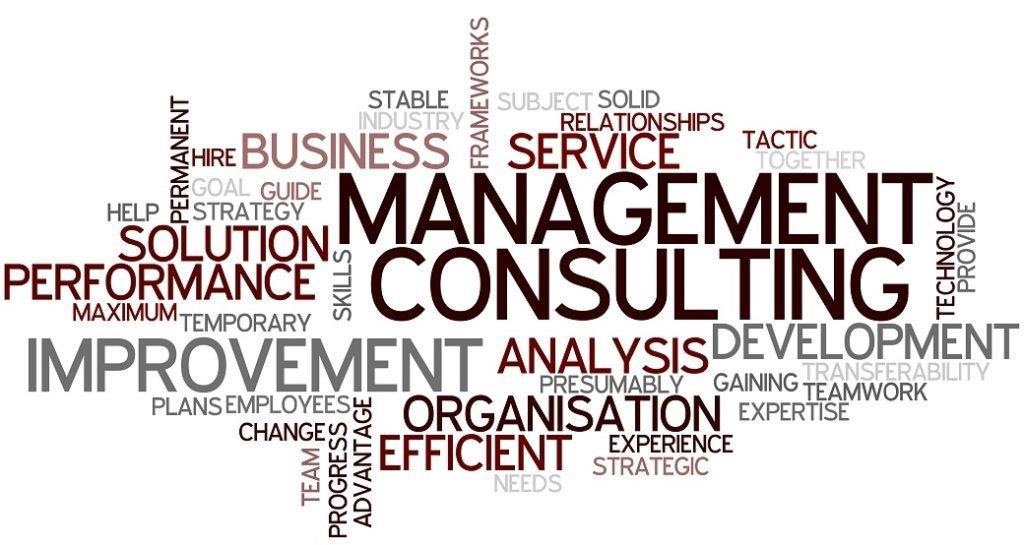
• Argyris and Schön (1996)Consultants as agentof change. Business consultancy is a process through which organisations learn. Business consultants are perceived as agents of change.
• Kaarst-Brown (1999)Role of consultants- There are five symbolic roles of the external consultantExternal consultants when called into work on an assignmentare actually beingmanipulated by theirclientwhose agenda has already been setin advance.
• Lippitt and Lippitt (1986)Role of consultants .There is no established role in business consultancy. Consultants fulfil a number of roles that they judge to be appropriate for the client’s situation.
• McKinley and Scherer (2000)Consultants as agents of change .Consultants’ writings on organisational changes drive topexecutives to restructure organisations. Consultants are agent of change
• Kinsely (1979) Role performance fluctuation. In business services, one must be aware that employees and managers efficiency fluctuates on a day to day basis.
• Kubr (1996) Role of consultants . Consultants have two basic roles: resource role and process role
• Lindon (1995) Role of consultants .Consultants role is to help managers to understand their problem, whilst not being responsible for solving it.
• Lippitt and Lippitt (1986)Role of consultants .There is no established role in business consultancy. Consultants fulfil a number of roles that they judge to be appropriate for theclient’s situation.
• McKinley and Scherer (2000)Consultants as agents of change Consultants’ writings on organisationalchanges drive top-executives to restructure organisations. Consultants are agent of change
• Pellegrinelli(2002: 353)Consultant /clientrelationship Investigated the interplay and tensions ofconsulting interventions.
• Schein (1988)Role of consultants in the consultancy process There are three types of consultancy: the expert, the doctor/patient relationship and the“ process consultation”. Schein focused his researchthe role that “consultation process”on plays on organisational development.
• Steele (1975)The learning process in consulting‘Learning is the essence of consulting’ (Steele, 1975: 190)
• Walker and Massey (1999)Skills transfer inconsulting Business consultancy is about transferring skills to both organisations and managers.
• Williams (2001) Client’s role inconsulting Consultants’ esoteric language gives meaning to concepts and actually help managers to understand better the problems they arefacing.
• Professional consultingrequires a multi-dimensional approach to leadership.
• Within the role, consultantsneed to be adept, confident and have credibility.
• Scenarios for consultingwill typically be complex and involve building relationships with other senior leaders.
• Consultantsmay lead internal and/or external teams and work at board level.
• Consultantsmust not only have a macro view of an organisation’s strategiccontext, they must also understand the impact of digital, technological and geo-political change.
• Defines, shapes and communicates organisational purpose,vision, mission, culture and values.
• Develops the strategic direction of the organisation.
• Developmentof strategic goals.
• Consider strategic options (e.g. risk, financial,reputational,legal, management, competitive advantage).
• Supports implementation of strategic plan.
• Creates and selects strategy. (Planned. Intended. Emergent. Deliberate. Opportunistic,Whittington,2000).
• Resource based view of the firm (Barney, 1991).
• Scenario planningand rational planningmodel. Strategic Planning as a Top Down/Bottom up process. The Five Ps of Strategy (Mintzberg, 1987).
• Leads the organisation ethically and legally in line with board and organisational governance.
• Diversity and Inclusion (Kirton et al. 2014).
• Definition and Values (Patrick and Kumar, 2012).
• Leads individuals and teams with impact (Belbin, 1981)
• Develops people and their capabilities.
• Collaborates with partners and manages complex relationships with multiple and diverse stakeholders/customers.
• Stakeholder management (Lindgreen et al. 2019).
• Anticipates and predicts future opportunities and threats for industry, sector, technical specialism (Horizon scanning).
• Initiates, leads change and innovation.
• Recommends types and approaches of change (e.g. incremental and transformational change).
• Identifies drivers of change and new ways of working across infrastructure, processes, people and culture and sustainability.
• Applies different theories/models of change (e.g. Eight Step Change Model (Kotter, 2012),
• Radical Change within Traditional Structures (Oswick, 2015)).
• Creates an environment for innovation and creativity.
• Selects and applies tools and techniques to support innovation and change.
• Drives continuous improvement (e.g. Kaizen).
• Selects and applies tools and techniques (e.g. LEAN methods (Krafcik, 1988).
• Six Sigma (Pyzdek and Keller, 2018).
• Statistical Process Control ‘SPC’(Salacinski, 2015).
• Applies soft systems thinking to understand complexity(Checkland, 1999; Senge, 1990).
• Recognises the importance of brand relationship and reputation management.
• Applies financial measures, considers financial sustainability and accountability.
• Manages resources and measures outcomes
• Professional consulting can be transformational, shaping the way organisations think and operate.
• Consultants may assist clients to develop strategic objectives, consider new market opportunities, explore innovative ways of working and build organisational and staffcapability.
• For professional consultants to deliver effectiveclient-centric consulting they must have an in-depth understanding of consulting practice.
Conceptualise a process for client-centric professional consulting

Conceptualise: Diagram, model, chart or graphic with annotations. Holistic overview of process.
Process for client-centricconsulting:
• Process tailored to the needs of client/own organisation (process can begin at any stage dependenton clientrequirement).
• Cycle of consultancy. Dimensions of consultingengagement(Newton, 2019).
• The Seven C’s of Consulting(Cope, 2010).
• Clientengagement(relationship building, trusted advisor). Customer Relationship Management(CRM).
• Identification of clientissue/requirementforconsulting.
• Consultingtype (e.g. process/expert).
Process for client-centric consulting:
• Identify/establish hypothesis for consulting.
• Proposal development (Freed and Romano, 2010).
• Negotiation (‘Getting to Yes’ Fisher et al., 2012).
• Gain agreement to proceed.
• Contracting.
• Data and information collection and analysis to test a hypothesis.
• Reaching a conclusion.
• Make recommendations.
Process for client-centric consulting:
• Develop plans to deliver the consulting recommendationsto respond to client issues/requirements for consulting.
• Implementplans (deliver consulting).
• Articulate lessons learnt.
• Evaluate outcomes.
• Close consultancy engagement(withdrawal phase).
• Conductimpact assessmentof consultancy.
• Assess learning needs of client.
• Determine opportunities for further consulting.
• Networking to develop client base (e.g. personal,professional,affiliations, associations,contacts).
• Marketing (e.g. developmentof strategies for new/existingclients (local, regional, national,global)).
• Marketing Mix (7 Ps of the Marketing Mix, Kotler, 2013).
• Frameworks for digital marketing communication platforms (e.g. R.A.C.E. model – Reach, Act, Convertand Engage (Chaffey, 2010)).
• S.W.O.T. Analysis.
• Ansoff’s Growth Vector Matrix (1957).
Approaches to identify and generate consulting opportunities:
• Porter’s 5 Forces Analysis Framework (1979).
• Facing the external environment (P.E.S.T.L.E.Analysis).
• Use of social media.
• Branding.
• Customer relationship management (CRM) operations.
• Referrals from existing clients.
• Register to receive consulting opportunities.
• Respond to consulting opportunities (e.g. RFP (Request for Proposal)). RFI (Request for Information).
• ITT (Invitation to Tender).
• Overview of proposed consultancy (Terms of Reference).

• Rationale for consultancy.
• Value proposition (the value the clientwill gain if they proceed with the
• consultancy).
• Statementof clientissue (e.g. areas to be addressed, beneficiaries of consulting, strategiccontext).
• Methodology (approach taken to consultwith client, activities/people involved in the consultancy, communication strategy).
• Evaluation/summary.
• Quality assurance (e.g. progress reviews/evaluation (lessons learned)).

• Terms of contract (e.g. cost, payment terms/schedule, liabilities, indemnities, confidentiality, ownership, delivery of consulting KPIs, risk management and mitigation).
• Additional information as specifically required by the client (e.g. client references, data and information, financial statements).
• Policies (e.g. equality and diversity, sustainability, conflict of interest, confidentiality).
• Clarification and conditions for consulting (e.g. reporting structure, organisational, legal and regulatory requirements).
• Proposal development is underpinned by professionalism (e.g. ethics, cultural norms, transparency, confidentiality, corporate social responsibility and sustainability, compliance with organisational, legal and regulatory frameworks).
Different clients:
• Publicsector (local and national government).
• Private.
• Third sector.
• Local, international, global, cross-borderorganisations.
• Internal.
• Projectand programme-based organisations.
• SMEs. Partnerships.
• Sole Traders.
• Limited liabilities Companies (LLPs).
• Consultancy engagement begins (e.g. Review aims, objectives, assumptions, hypothesis which form the basis of consulting.
• Determine/allocate resources.
• Scope and plan delivery.
• Appraise type/level of involvement with client.
• Risk management strategy).
• Collect, analyse data and information/evaluation of the impact of data and information on hypothesis for consulting.

• Apply principles of design thinking (Dorst, 2015 and Kolko, 2018).
• Consider evidence against original hypothesis for consulting.
• Make sense of ambiguity (e.g. accept, reject, develop, revise findings.
• Negotiate.
• Make trade-offs.
• Agree nature, content, format, delivery of outcomes).
Methodologiesfor deliveringclient-centricconsulting:
• Communicate recommendationsin a straightforward, understandable and non-technical manner (Communicate,counsel, consult, provide advice and guidance to client throughout engagement (Patterson et al., 2011).
• Implement delivery methodologies (e.g. Project management methodologies: PRINCE2, PMBOK, Agile, Waterfall, Six Sigma Project, SCRUM).
• Organisational strategies/tools.
• Devise quality assurance strategy (reporting and monitoring against KPIs, ROI and SROI (Social Return on Investment)).
• Resource management plan (e.g. finance, people,
• Deliver recommendations which add value to the client’s organisation/individual on conclusion of contract.
• Measure success (short, medium, long term).
• Determine client satisfaction.
• Maintain and grow client contact/strategic business network.
• Add value through coaching, education (for an agreed period) to support client in new ways of working/transfer of capability.
• Offer networking opportunities/introductions for client.
• Compliance to organisational, ethical and legal frameworks (e.g. Bribery Act, 2010).
• The ability to drive innovation and change is an essential skill for a professional consultant.
• Innovation defined simply as ‘doing something new or different’, is a powerful catalyst for change.

• It can revolutionise an organisation’s operational activities, create dynamic new opportunities, and contribute to the achievement of strategic goals.
• Change occurs in many forms and professional consultants must be able to lead changes, which may be radical, incremental or evolutionary.
Innovation and change: Innovation is the activity of doing something new or different.
• Achievementof objectives, environmental, internal and situational factors,changing market positioning, entry to new markets products and services.
• New operational processes and procedures.
• Response to customer demands.
• Impact of big data, information,knowledge capital and creativity.
• Stakeholder involvement(individuals, pressure groups,interestgroups,media).
The rationale for innovation and change
• Competitiveness, reputation, good practice, ethics,
• Corporate Social Responsibility (CSR), shiftingcultures, diversity, emergingstrategy, governance.
• Improvingorganisational performance, systems, quality and efficiency, service delivery, processes.
• Organisational survival, consolidation.
• Upgradingthe business model (e.g. offer complementary services or products).
• Response to digitalisation, technological change, disruptive technologies (Christensen, 1997; World Bank, 2019).
• Finance and resourcing, legal and regulatory and organisationalrequirements.
Leading innovation and change through professionalconsulting
• Organisational contexts:
• Type and purpose of the organisation (operational, local, international, global, project/programme management, departmental and strategic business unit),
• TRIZ/TIPS ‘inventive problem solving’ (Altshuller, 1984).
• Open and closed innovation (Chesbrough, 2003).
• Commercialisation and viability of the process, idea, opportunity. Assessing the competition, using research to drive ideas. Ideasdriven innovation.
• Educate “growth mindset”, learning from mistakes.
• Market/customer driven innovation.
• Analysis driven innovation.
• Continuous product and process improvement.
• Service design (Shostack et al., 1982).
• Design thinking, IDEO (Stefan and Nimgade, 2000, revised 2017).
• Synectics – creativity and problem solving(Arthur. D Little Invention Design Unit, 1950s; Gordon, 1961; Boland Jr. et al., 2008).
• Networking and Communities of Practice (CoPs).
• Value propositiondesign (Osterwalder et al., 2010).
• The entrepreneur as a disruptor. The use of disruptive technologies and digitaltechnologies (Christensen, 1997).
• Behavioural approaches to promote innovation: (e.g. inclusive, agile, flexible, creative (Amabile, 2012), enterprising, solution focused).
• Recruitment and employment of innovators (value individuals who think differently).

• Incentivised innovation (e.g. reward and recognition).
• Responsive to challenges and barriers which impede innovation and change.
• Use of coaching and mentoring.
• Negotiates, influences, communicates using emotional intelligence (Goleman, 1998).
• Collaborative approaches to innovation across sector, company and teams.
Traditional approaches to change:
• Leadership-driven (top down) tried and tested, experience based, transactional, change agents. Focus on the past to act in the present, cultural change.
• Powerthrough hierarchy, mission and vision, makingsense through rationale argument. Freeze phases (Lewin, 1947).
• Force Field analysis (Lewin, 1948).
• Change rollercoaster (Kubler-Ross, 1969).
• The Prosci change model ‘ADKAR’ (Hiatt, 2003).
• Eight guidingprinciples forchange management(Kotter, 1995).
• The change equation (Beckhard, 1969).
• Navigatingthe transitions of change (Bridges, 1991).
• The four stages of major change (Longaker, 1993).
• Managing at the speed of change (Conner, 1992).
• The Change Masters (Hailey and Balogun, 2002).
• Change Equation (Moss-Kanter, 1983).

Contemporary approaches to change:
• Acting in the present to impact the future: Top down and bottom up leadership, emergent, tropic, rhizomatic and spontaneous, power through connections and networks, shared purpose (Oswick, 2010).
• Purpose of a system is what it does ‘ POSIWID’ (Beer, 1960).
• Making sense through emotional connections.
• Open approaches, sharing ideas, co-creating change.
• Relationships and networks.
• Taking a holistic ‘Helicopter view’ (Morgan, 1985).
• Outcomes driven. Co-creation. Open and closed systems. Inter and intra relations (Ulrich, 1983).
Contemporary approaches to change:
• Multiple perspectives analysis (Linstone, 1976).
• Boundary critique (Ulrich, 2002).
• Divergent and convergent thinking.
• Radical Change within Traditional Structures (Oswick, 2015).
• Organisational congruence model (Nadler and Tushman, 1997).
• Managing change ‘Systems Intervention Strategy’ (Mayon-White,1985).
• Appreciative Inquiry (Cooperrider and Srivasta, 1987).
• AuthenticLeadership (Goffee and Jones, 2011).
• Entrepreneurial Leadership (Roebuck, 2014).
• Transformational Leadership (Bass and Riggio,
• 2006). Situational Leadership (Hersey and Blanchard, 1969).
• Five Practices of Exemplary Leadership (Kouzes and Posner, 1987).
• Leadership Styles (Goleman, 1995).
• Distributed Leadership (Roe, 2020).
• The Servant Leader(Greenleaf, 1977).
• Approaches which supportmental health and wellbeing.
• Stress management.
• Employee engagement.
• Minimise unwanted disruption.
• Manage conflicts and tensions (e.g. within and between stakeholdergroups).

Client requirements
• External and internal business drivers.
• Responseto digitalisation, new, disruptivetechnologies (Brand, 2005).
• Markets and customer expectations.
• Legal and regulatory requirements.
• Environmental factors.
• CSR and sustainability.
• Economic opportunities.
• Diversification.
• Cultural shift.
• Process improvement.
• Leadership change.
• Organisational changedevelopmentand design.
• Restructure.
• Consolidation.
• Innovation.
• Expansion. Merger. Partnership.
• Divest.
Develop strategy:
• Application of theoretical approaches to change (e.g. to scope, plan, drive,
• deliver, and evaluate change).
• Leadership and managementapproaches to engage with stakeholders throughoutprocess.
Implementation strategy:
• Big bang strategy.
• Kaizen.
• Prototyping.
• Developingapilot.
• Parallel operations
Implementation plan to lead/drive the change process:
• Key features (e.g. scope of change, objectives, actions, stages, milestones, resource requirements, learningand development).
• Establish roles and responsibilities.
• Set KPIs.
• Establish a culture of continuous improvement.
• Risk management.
• Quality assurance.
• Communication strategy and plan (internal and external communications, i.e. presentations, meetings and briefings, use of media, consultations, huddles,
• webinars, podcasts, conference calls, blogposts, letters, articles, case studies).
• Communicationskills (e.g. emotional and social intelligence, influencingand persuasion, use of clear, succinct language appropriate to the audience.
Implementation plan to lead/drive the change process: Assessment and response to barriers and challenges (internal and external):
• Logistical barriers.
• Working patterns such as remote, virtual, shift working. Finance.
• Influence of trades union and professional bodies.
• Changingmanagement priorities.
• Levels of commitment, motivation, delayingtactics.
• Cultural dimensions of innovation(diversity, ethnicity and gender divide to entrepreneurial practice).
• Group Think (Janis, 1982).
• Organisational politics.
• Supplier power. Buyer power. Bargainingpower. Competition. Threat of substitution. (Porter, 1979).
Implementation plan to lead/drive the change process:
Application of decision-making tools, techniques:
• Attribute trade off models (MRD/ARM Analysis).
• Use of Logframes (U.S. Agency for International Development,1969).
• The Pugh matrix (Pugh,1980).
• Quality Function Deployment ‘QFD’ (Akao, 1966).
• Pareto analysis.
• Decision trees.
• Sensitivity and what if analysis. OODA loops (Boyd ,1985).
• Monte Carlo Simulation Method (Ulam, 1947).
• Six Thinking Hats technique (De Bono, 1985).
• Multi Voting / Delphi Technique (1944).
Develop a strategy for leading and managing change in response to a client requirement
Implementation plan to lead/drive the change process:
Application of project management approaches
• PRINCE2, PMI (Project ManagementInstitute).
• APM (Association of Project Managers).
• PMBOK (Project ManagementBody of Knowledge).
Implementation plan to lead/drive the change process:
• Application of tool/s to review the impact of change:
• Periodic reporting, surveys and questionnaires, benchmarking activities, balanced scorecards (Nolan and Norton, 1992).
• Post implementation reviews.
• Application of quantitative techniques e.g. data and metrics, audits, targets, statistical analysis (e.g. SPC).
• Qualitative techniques e.g. interviews, observation, walk through,
• conversations.
• Framework Analysis (Pope et al., 2000).
• Thematic Network Analysis (Attride-Stirling, 2001).
• Systematic/systemic triangulation (Urich, 1983).
Client-centric: e.g. consulting with individuals, teams, board members.
Challenges in leading others:
• Understanding of who is leading and who is being led.
• Scope of leadership (e.g. leading consultants, clients, researchers, administrators, other team members, suppliers, partners).
• Different organisational behaviours and knowledge requirements.
• Leading without authority.
• Lack of buy-in from individuals within client organisation.
• Ability to adapt leadership style (adaptability).
Client-centric: e.g. consulting with individuals, teams, board members.
Challenges in leading others:
• Establishing credibility (e.g. leadership credentials not recognised, disconnect between industry specialists and career consultants).
• Communication breakdown/lack of communication.
• Ability to interpret and articulate solutions back to the client.
• Client perception (e.g. challenges are unique to the sector).
• Delivering difficult news.
• Articulating value of consultancy (e.g. financial and non-financial benefits). Reputation/stereotypes regarding consultants.
Challenge in relation to own and client’s organisation:
• Organisation Type (e.g. local, international, global, project/programme based, operational, departmental or strategic business unit).
• Organisational purpose (strategic definition, vision, mission).
• Strategic narrative (historical perspective).
• Governance (e.g. public, private, third sector).
• Legal status of the organisation.
• Levels of organisational maturity.
• External environment.
Challenge in relation to organisational culture
• Myths, stories, systems, processes, structure, internal politics, structure and demographic of the workforce (Cultural Web Johnson et al., 2011).
• The Three Levels of Culture (Schein, 1992).
• Internal factors. ‘The way we do things around here’ (Deal and Kennedy, 1982 & 2000).
• Internal influences (Hofstede, 1980).
• Toxic cultures (e.g. leadership, bullying, discrimination, me first attitudes, hostility, infighting).
• Competing Values Framework (Quinn and Rohrbaugh, 1983).
• Performance targets.
• Organisational climate (e.g. short-term peaks and troughs in operational activity, seasonality).
• Change (e.g. projects, innovation, restructuring, new ways of working, leadership).
• Challenges in relation to digital landscape, impact of disruptive technologies.
Learning and skills development.
• Coaching and mentoring.
• Talent management.
• Reward and recognition.
• Role requirements/role modelling.
• Succession/pipeline planning.
• Equality diversity and inclusion (Equality Act, 2010).
• Corporate Social Responsibility and sustainability.
• Human resource management (Beardwell and Thompson, 2017).
• Human resource development (Ulrich and Brockbank, 2005).
• People : individuals or teams.
• Own organisation or client organisation.
• Development of healthy work systems.
• Targeted approaches to tacklingstress, anxiety, depression.
• Fair and decent work (The Taylor review of modern working practices, 2017).
• Flexible working/work life integration.
• Safeguard of individualsrights and responsibilities.
• Creatingsafe environments which enable mental health and well-beingto be discussed.
• Removal of structures (e.g. selfdetermined annualleave, empowered individuals (Ricardo Semler,1993)).
Approaches to valuing people and promoting mental health and well-being:
• Mental Health First Aid.
• Building confidence, rapport,trust.
• Honest conversations (Miles,Munilla and Darroch,2006; Beer and Eisenstat, 2004).
• Social corporate responsibility as part of community to reduce discrimination and offer opportunities to all.
• Embedding/promotingequality, diversity and inclusion into overarchingaims and objectives of an organisation.
• The case for equality, diversity and inclusion (Kirton et al. 2014).
• Valuing diversity (Griggs, 1995).
• Super-diversity (Vertovec, 2007).
• Turningadversity into competitive advantage (Sutanto,2010).

• Relationship between initial proposal and delivery of professional consulting
• Delivery of client benefits and quality assurance (e.g. achievement of the value proposition against client requirements (e.g. achievement of KPIs, ROI, SROI and milestones).
• Ability to take responsibility, recommend modifications. Make decisions (strategic/tactical) take corrective action on major issues (e.g. scope creep, time, failure to achieve KPIs/milestones, budget overruns, quality)).
• The effectiveness of strategies/theories/ advice used and/or provided during the consulting engagement (e.g. ability to apply principles of design thinking (Dorst, 2015 and Kolko, 2018)).
• Ability to balance client needs with own organisation’s values (e.g. applicationof policy, procedure, legal, ethical requirements, corporate social responsibility and sustainability).
• Ability to remain a trusted advisor. Develop professional relationships and network with client/relevant stakeholders.
• Communicate with key stakeholders effectively (short, medium, long term).
• Communicate, counsel, consult, provide advice and guidance to client throughout engagement (Patterson et al. 2011).
Reflective practice approaches:
• Model of Structured Reflection (Johns, 1995; 2006).
• Reflective cycle (Gibbs, 1988).
• Experiential/learning cycle (Kolb, 1984).
• 3 stem questions (What? So What?
• Now What?) (Borton, 1970; Driscoll, 1994, 2000, 2007).
• Reflection before action-reflection in action-reflection on action (Schön, 1983).
• Appreciative Inquiry (Cooperrider and Srivastra, 1987).
Recommendations to improve the delivery and strategic impact of professional consulting:
• Ability to lead self and others.
• Lead change.
• Manage conflicts.
• Communicate and build stakeholder relationships.
• Application of theories, models and frameworks. Terms of contract (e.g. KPIs, ROI, SROI).
• Resource managementplan (e.g. finance, people, technology, materials). Use of technology.
• Compliance with organisational,ethical and legal frameworks.
• Managementof data and information.
• Time management.
• Managementand mitigation of risk.
• Building client capability.
• After establishing the aims and objectives, the actual process of consultation will need to be planned, i.e.:
• Who are the key stakeholder groups?
• How accessible are they?
• Are there any hard-to-reach groups?
• How can their co-operation and engagement be gained?
• What is the best method of consulting with the groups?
• What do they need to see beforehand?
• How can this be disseminated?
• Will any pre-consultation be required to prepare stakeholders for the exercise?
• The method of consultation will need to be identified, balancing the resources available and the level of feedback required.
• The “process” stage is the “doing” stage; this involves carrying out the consultation. Good planning will ensure this stage runs smoothly. Considerations in this stage mainly centre on developing effective relationships with stakeholders and facilitating open and honest sharing of views, and accurate recording of the process and the data.
• The next stage, “presentation“, is concerned with the analysis and the reporting of the data. The data will need to be analysed and reporting prepared for the relevant audiences i.e. back to the corporation, to policy makers, etc. but also feedback to those who have engaged in the process and taken part. The form of reporting will need to take into account audiences and ensure the highest possibility of actions as a result of the consultation.
• The final stage relates to actions as a result of the consultation; the “promise“. Part of the process of engaging with stakeholders is the investment in a longer-term relationship of mutual benefit and trust.
• Without demonstrable use of stakeholder feedback in resultant action, this can be damaged. The final stage, therefore, has an element of PR contained within it; communications about resultant actions need to be carefully considered to reach stakeholder audiences.
• Ability to build and sustain extensive/diverse stakeholder networks and collaborate with others in target organisations,industry bodies,intermediaries and in own organisation(Lindgreen et al., 2019).
• Ability to influence, persuade,motivate and engage others to realise objectives (Jung, 1921; Graves,1970; Carnegie, 1936).
• Ability to show a genuine interestin stakeholders’thoughts,ideas and expectations.
• Ability to create an environmentin which team members find common ground, builds mutual respect and fosters team cohesion (Belbin, 1981).
• The term stakeholderfirst “appeared in the management literaturein an internal memorandum at the Stanford Research Institute, in 1963” (Freeman, 1984, p. 31).
• The word means “any group or individual who can affect or is affected by the achievementof the organization'sobjectives” (Freeman, 1984, p. 46).
• Bryson (1995, p. 27) proposed a more comprehensive definition for the term: “A stakeholderis defined as any person, group, or organization thatcan place a claim on an organization'sattention, resources, or output or is affected by that output”.
• Power-Interest Grid Source: Eden and Ackermann (1998) cited in Bryson, John 2004. “What to do When Stakeholders Matter: Stakeholder Identification and Analysis Techniques.” Policy Management Review 6(1): 2153.
• The power-interest grid, as shown to the right, helps to visualise the positions of individual stakeholders and the relations among them. The two dimensions of the grid – power and interest – speak to the reality that not all of the players who have an interest in agricultural land use planning also have power to influence decisions. The two-dimensional grid generates four categories of stakeholders:
Players: have both an interest and significant power
Subjects: have an interest but little power
Context setters: have power but little direct interest
Crowd: have little interest or power
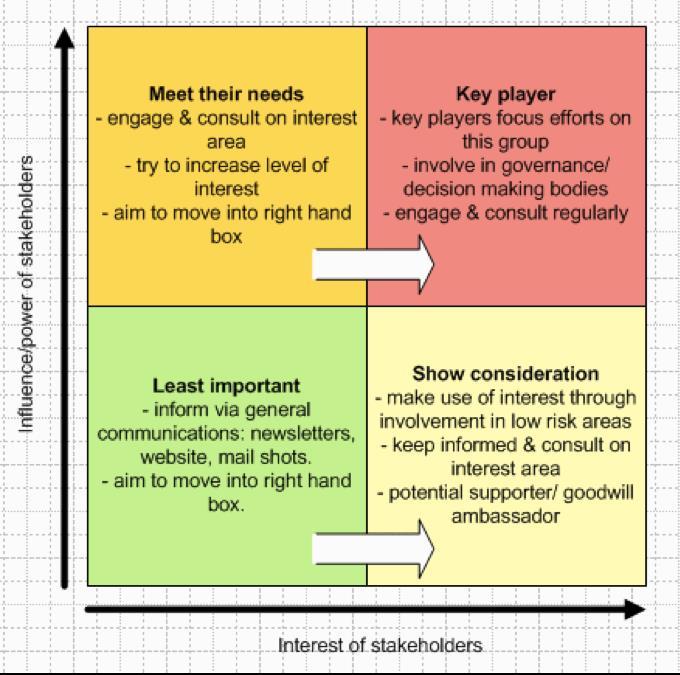

•
• "There is no one 'right' or 'best'culture for an organisation - only the appropriate culture for the business environment (Gareth Jones and Rob Goffee)."
• This concept explores how organisations build up their own culture through tradition, history and structure. It also suggests that culture provides organisations with a sense of identity.
• Organisational culture is a pattern of basicassumptions invented, discovered or developed by a given group within an organisationas it learns to cope with its problems of external adaptationand internal integration. The pattern has worked well enough to be considered valid and therefore is to be taught to new members as the correct way to perceive, think and feel in relation to problems (Schein, 1988; 1996).
"It is now widely accepted that leaders of an organisationshape its culture (Northouse, 2001)."
• Highly effective leaders develop styles that are clearly aligned with their team and organisational culture. Important differences between leadershipstyles are described, with case studies from across industries to highlight the benefits and drawbacks.
• Kurt Lewin and his colleagues conducted research on different leadershipstyles, classifyingthem into three types: democratic, autocratic, and laissez-faire (Lewin et al., 1939). These styles can be placed on a continuum of control:Firstly, Autocraticwhere the leader tells people what to do, an authoritarianstyle. Democratic, where teams participate and collaborate in decision making, but the leader still has final say. Finally, laissez-faire - a hands off approach where employees choose for themselves what the best option is with little to no control from the leader (Robinson, 2010).

BUSINESS ETHICS AND CORPORATE SOCIAL RESPONSIBILITY
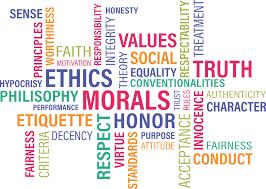
• Respectfor Others: Leaders with ethical qualities act theirfollowers with esteem and regard. This indicates that ethical leaders act individuals as results in their own rather than as channels for arriving at their results.
• Service to Others: Among the qualities of ethical leadership is servingthe followers. They act in a humane manner which is in contrary to acting in an ethical egoistway. This kind of leaders regard theirfollowers very highly. Theirmain purpose of life is to espouse and encourage theirfollowers. Providingservice to other individuals is demonstrated by means of conducts includingcounselling, creating teams and authorizing(Mendonca and Kanungo, 2007).
• Impartiality for Others:Leaders with ethical attributes guarantee that impartiality and righteousness are critical qualities of theircourse of decision making. This suggests that every single followeris treated in rather comparable manners excludingthe case that there is an obvious requirementforspecial handlingand the reason for this special handlingis clearly known. Alongwith this clearness, the reason forthe special handlingneed to be ethically sensible and acceptable (Mendonca and Kanungo, 2007).
• Honesty towards Others: Honesty is another critical quality of ethical leadership. The lack of honesty undermines trustwhich is an essential feature of an association between leaders and their followers. Conversely, honesty nurtures trust and establishes the association between the leaderand the followers.

• "The prevailingapproachesto CSR are so disconnected from business as to obscure many of the greatest opportunities for companies to benefit society (Porter and Kramer, 2006)."
• This concept explores the differentways in which CSR is defined and provides an account of success factors and business evidence.
• Corporate Social Responsibility Definition
• Corporate social responsibility (CSR) is the continuingcommitmentby business to behave ethically and contribute to economic developmentwhile improvingthe quality of life of the workforce and their families as well as of the local community and society at large (World Business Council for Sustainable Development,1999).
• "When firms “act”, they are expected to meet a minimum set of standards and obligations as morally defined and evaluated by these individuals and groups (Werhane and Freeman, 1999)."
• Businesses face ethical issues and decisions almost every day. The concept explores what is means for companies and what they can do to coordinate the interests of their stakeholders.
• Business Ethics Definition
• Business ethics is “the degree of moral obligation that may be ascribed to corporations beyond simple obedience to the laws of the state” (Kilcullen and Kooistra, 1999). It concerns “business situations, activities, and decisions where the issue of right and wrong are addressed…[meaning] morally right or wrong as opposed to, for example, commercially, strategically, or financially right or wrong” (Crane and Matten, 2007).
• Professional Ethics - Moral principles and standards that govern the conduct of the members of an organisation.
• Ethical Fundamental Principles – Integrity, Objectivity, Confidentiality, Professional Behaviour and Professional Competence and Due Care
• Corporate Code of Ethics – it is a formal written Code of ethical behaviour, created by the boards of directors of a business that is available to all employees and serve as guide to all decisions and actions.
• Corporate Social Responsibility – is business' commitment to carry out all activities in an ethical way, taking account the social, economic and environmental impact, and human rights.
• Moral and Social Responsibility - businesses are accountable for comply with their social responsibility and all actions and decisions of the business must not disrupt stakeholders interest - balance between economic growth, welfare of society and environment

Stakeholders - is any person, organization, local community who can affect or be affectedby the business's actions, goals and policies.
Primary Stakeholders
• Shareholders
Customers
Employees
Business Partners
Community and Environment
• Have more interest in the business outcomes since are directly benefiting from or affected by the business activity
Secondary Stakeholders
• Government and Regulatory Bodies
Competitors
Trade Groups
Civic Organizations
Media
• Don not have a direct participation in the activities of the business but they are affected by or can affect its actions
• Primary Stakeholders have a higherinterestin the business due to higherrelevance in the business. Customers have high interest in the CSR activities of the business, since they want know how this will impact the products and services provided by the businesses.
• Employees, in otherside, have interestin the benefits and improvements that CSR can bring to their workplace and balance between work and personal life.
• Finally, Shareholders, as main investors in the business, have interest in the financial benefits that CSR can bringto their operations.
• Secondary Stakeholders as Governmentand Regulatory Bodies evaluate how businesses are followingCSRprocedures and comply with their legal duties. Otherstakeholders as Trade Unions will look for compliance of the business in the employment law.
• The main benefits for a business for the complianceof the CSR regulationsare:
• Customer satisfaction and retention, and increase of future contracts
• Increase reputation and differentiation from the competitors
• Boost shareholders and investors confidence
• Happier and more skilled workforce
• Administration and operation costs reduction
• Attractive position in market and more funding accessible
• Financial reports are formal records of all financial transactions of the business which are used to communicate final informationto the stakeholders.
• Financial reportingincludes the following:
• Income statement – shows the profit and loss duringa period of time. The amount of profit or loss is calculated by addingall revenues and subtractingall expenses relatedto operatingand non-operating activities.
• Balance sheet – shows the financial position of the business where displays the assets and how the assets are financed, by either debt or equity. Business can calculate their profitability (gross profit margin, ROCE and OperatingProfit Margin), liquidity (current and acid test ratio) and financial (Receivable, Payable and Inventory Collection and Turnover) efficiency with the figures shown in the statement.
• Statement of cash flows - acts as a connection between the income statement and balance sheet, this is by showing the cash inflows and outflows. An analyse of operating activities ( principal revenue-generating activities of an organization and other activities that are not investing or financing),
• Investing Activities ( cash flows from the acquisition and disposal of long-term assets and other investments not included in cash equivalents) and
• Financing Activities ( cash flows that result in changes in the size and composition of the contributed equity capital or borrowings of the entity )
• Statement of stockholders'equity -shows the changes in all of the major equity accounts which reports the transactions that increase or decrease the equity accounts during an accounting period.
• Finally Notes to the financial statements – they are disclosures which allow additional information not included in the financial statements such as accounting methods used, change in methods used in previous reporting periods and in future transactions that may affect future profitability.

• “Corporate Governance is the system by which companies are directed and controlled”
– Cadbury Report 1992
• CorporateGovernance is a set of relationshipsbetween the directors of a business,shareholders and remain stakeholders and also provides the structure which builds the foundationwhere the objectives of the company are set, and how those objectives will be achieved and monitored duringthe business activity.
• Fairness – All decisions and values must be balanced by taking into account all stakeholders who has a legitimate interestin the business.
• Transparency – Open and clear disclosure of all information and financial statements to all shareholders and stakeholders.
• Innovation – Recognize that the needs of the business and stakeholders an change and this can impact how a business complies with codes of corporate governance.
• Scepticism – Be open and questioningdecisions mustbe always be engaged to effectively challenge managementdecisions.
• Independence – Independentof mind and appearance according ethical code
• Honesty – Truth tellingand not misleadingstakeholders
• Responsibility – Management is responsible and should act when corrective actions are required and penalize mismanagementof any level.
• Accountability – Be answerable forthe consequences of theirdecisions to shareholders and stakeholders
• Reputation – Follow corporate governance ethical behaviourand neverjeopardize business by poormanagement
• Judgement – Take decisions thatenhance business prosperity
• Integrity – Straightforward dealing, honesty and completeness.
• Corporate Governance is important for the good governance of a business. This is creates and develop:
• Management, awareness, evaluation and mitigation of risk – have an adequate and appropriate systems in place;
• Overall performance is enhanced by good management within set practice guidelines in place;
• Attract new investment and improve credibility next to the investors
• Wiliness to apply the good practices and have clear roles and duties establishin all business areas.
• Be accountable in all governance framework not only to the shareholders but all stakeholders
• Provides a framework to pursue the objectives of the business in an ethical and effective way which create safeguards against misuse of resources and information of the business
• Corporate Governance compliance gives a good reputationand confidence next to publicand government authorities and regulatorswhich protects value of shareholder’s investment
• Ethical behaviour can be achieve through:
• Effective management – unsure adherence to ethical behaviour
• Convey and reinforce the guidelines related to corporate governance
• Promote integrity – meaningstraightforward deals and completeness
• Underpin investor confidence
• Maintain the independence and ensure ethical principles are reinforced alongthe business, increasingcredibility with the workforce and working towards the same objectives
• Encourage more proactive involvement – increasingteam work and productivity
• Provide accurate and timely reportingand operationaldata, allowingto rectify and plan the business activities in a more beneficial way for the business and for employees.
• Business can increase their operational risk - risk that arises from the way in which an organisationoperates its business functions such as Reputational risk, Process risk – processes used by organisation,People risk
• System risk – control over access to system information and use of it, Legal risk, Event risk and Risk of unethical behaviour– code of conduct. In a business when ethical issues arise, the issue must be identify and the correct course of action take in ethical issues and eliminateor minimize the issue.
• Examples of ethical issues are, as followed:
• Decision making issues – arisingfrom puttingprofits above the consumer protection and fair treatment (example tax avoidance)
• Inappropriate behaviours and discriminationinside the workplace – ensure all employees feel secure and respected (example falsifyingdocuments and reports).
• Inappropriate incentive systemsin place which not give the same opportunities to employees and compensationare not distributed fairly (example fraud);
• Failingto comply with government regulationand laws, manipulate financialstatements to enhance position next to the investors and jeopardize the reputationof the business (illegally evadingtaxes).
• Practical steps that should be taken to deal with ethical situations:
• Analysis of the situation
• Identifyingthe ethical issues
• Consideringthe alternative options according corporate governance guideline
• State the best course of action based on the steps above
• Document and report the situation to higher management
• Codes of conduct:
• Professional Code of Ethics
• IESBA Code of Ethics
• IFAC Code of Ethics
• UK Corporate Governance Code
• Greenbury Code, Hamper & Cadbury Report
• OECD (Organisation forEconomic Co-operation and Development)
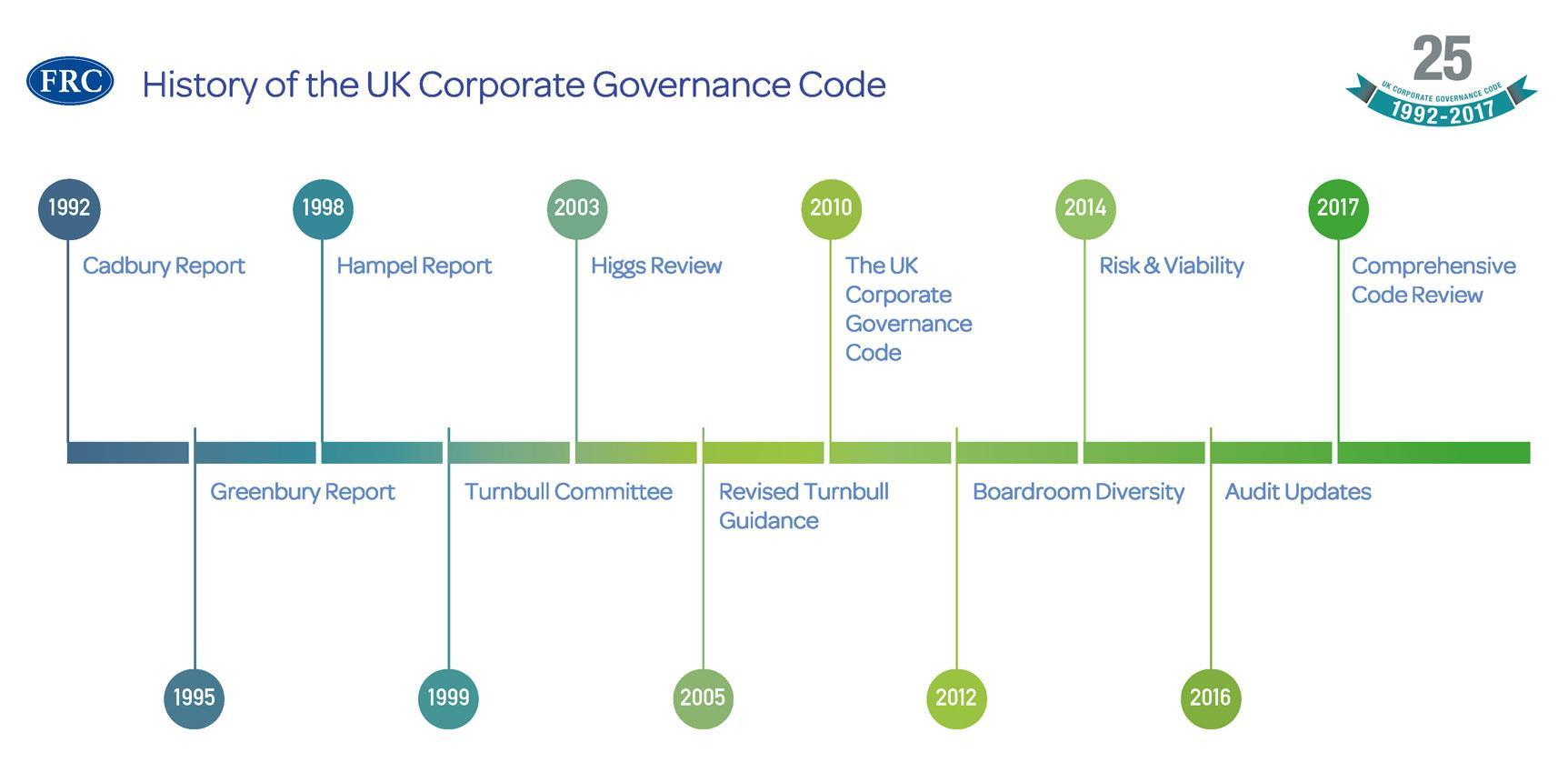
• Development of a leadership culture within the firm that pressures the importance of obedience with corporate governance and act in the stakeholders interest
• Policies and procedures to apply and evaluate quality control of engagements
• Policies are documented relatedto the identification of threats, compliance with the fundamental principles of governance, the evaluation of the significance of threats and the identificationand the application of safeguards to eliminate or reduce the threats
• Timely communication of a business’s policies and procedures, includingany changes to them •
• Educational, training and continuous professional development requires to maintain professional due care in all matters of business
• Disciplinary systems in place to promote compliance with the policies and procedures of business
• Create and make available policies and procedures to encourage and empower every member to communicate to management within the firm any issue related to compliance with the fundamental principles.
• Discussing ethical issues in board meeting to assess the strategies adopted by the entity will not be affected by any ethical issue.
• Effective systems operated by the employing organisation, which allow colleagues, employers and any member of the public to identify unprofessional or unethical behaviour
• An explicitly responsibility and duty to report breaches of ethical requirements.
Chand, S. 5 Different Approaches towards Ethical Behaviour in Business

1. Teleological approach:moral conduct is determined based on an activity’s consequences
2. Deontological approach:the focus is placed on what the most “right” option is, based on moral principles
3. Emotive approach:based on an individual’s emotions, not on morals and ethics
4. Moral-rights approach:views behaviour as protectingand respectingfundamental humanrights and equal treatment on behalf of the law
5. Justice approach:based on the fair treatment of all people accordingto specified standards
Chand, S. 5 Different Approaches towards Ethical Behaviour in Business
• The UK Governmenthas played a very importantrole in regard to the promotion of corporate social responsibility for the last 40 years.
• There are four main strands to the United Kingdom Government’s involvements regardingCSR and their activities:
1. Environment(environmentand estates): The UK Governmentis committed to reducing their direct impact on the environmentthrough the active managementof their emissions, consumption of natural resources,and waste.
2. Procurement(purchasingand finance): Regardingthe lifespan of a project, the UK Governmenttries its utmost to establish a procurementroute which is the most beneficial as far as CSR is concerned. This means that 90% of the government’s supply train contracts are implemented and maintained via the use of government frameworks.
3. Community (skills matching, fundraising and volunteering): The UK Government believes that it is important to build a sense of community and have a positive impact on society, and therefore, it has created a culture which promotes employee skills matching, fundraising,and volunteering.The government also actively supports local communities and businesses in which it operates.
4. People (health, wellbeing and human resources):
The UK Government aims to develop a workplace that encourages equal opportunitiesfor everyone as well as diversity. It serves to support employee wellbeing and health and it actively encourages personal developmentthrough a program called “five-days-a-year” learning programme.
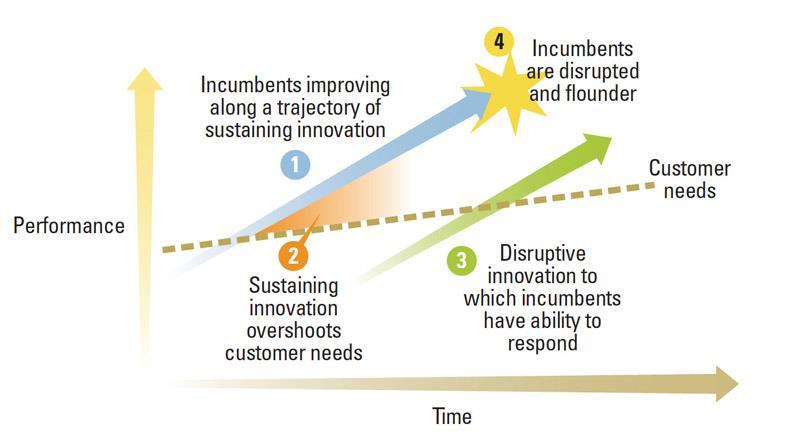
Financial sustainability, accountability, competitive advantage (Hoskisson, Hitt and Ireland, 2004).
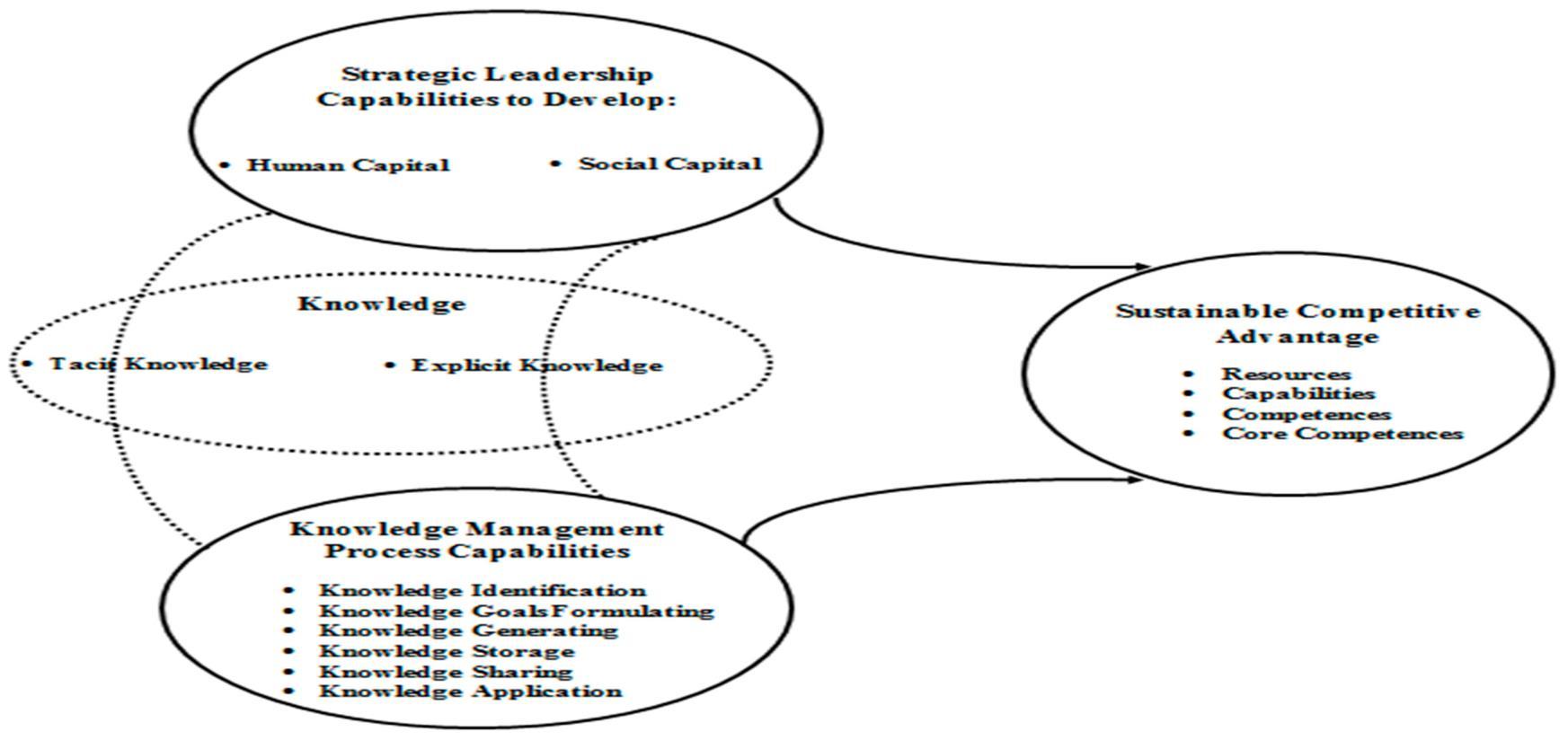

Applies emotional and social intelligence (Goleman, 2006).

Organisational silence ‘why organisations don’t communicate’ (Morrison and Milliken, 2000).


Ethical, authentic (George, 2003).
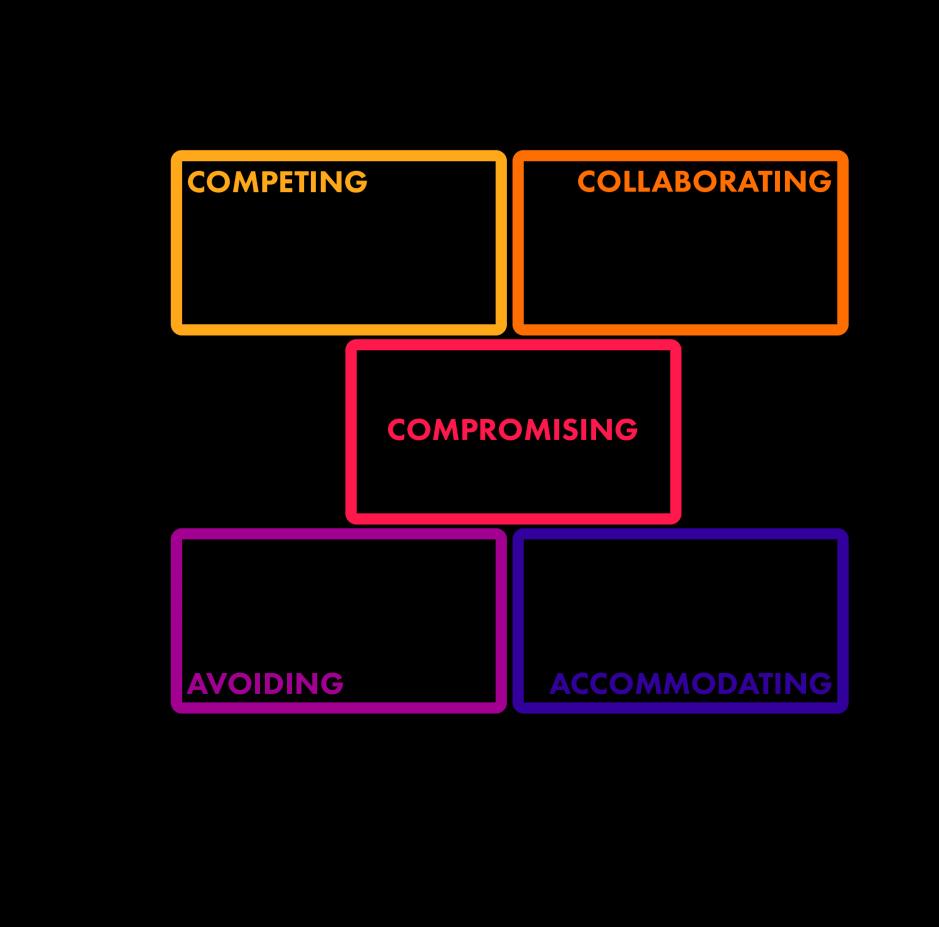

Elements of strategic management, adapted from Johnson and Scholes (1993).
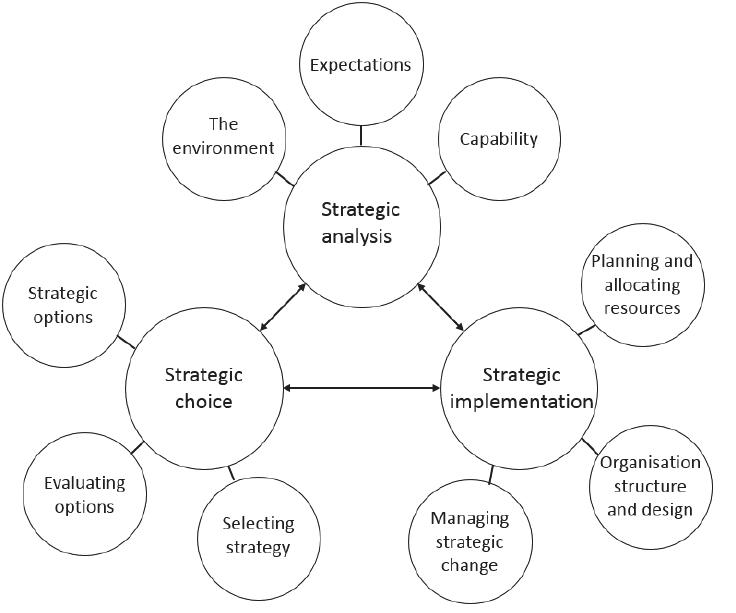

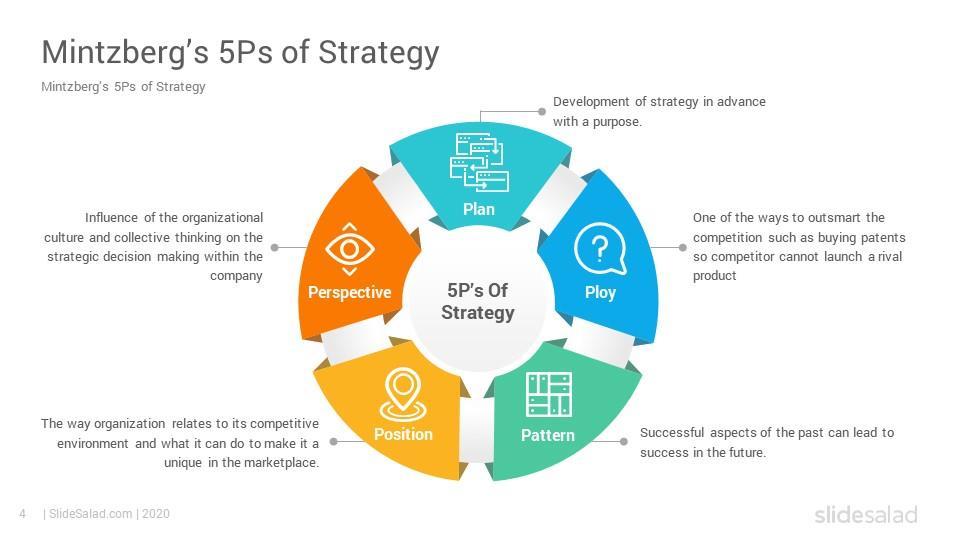
"Strategic planningconcerns how an organisationmakes sense of where it is going, and the path it will adopt to get there (Kaplan and Beinhocker, 2003)"
This concept reviews the process of strategic planningand shows how companies can implementstrategies to enhance company and productcompetitiveness. It also offers a summary of the benefits of the process and examples of its application.
Strategic planningis a disciplined effortto produce fundamental decisions and actions aimed at shapingthe nature and direction of an organisation’s activities (Bryson,1988; Rudd et al., 2008).
"Strategy should reflecta distinctive value chain that configures all key business processes and operations (operations, HRM, marketing, service delivery, etc.) in a unique way that is difficultforcompetitors to imitate (Porter, 2001)."
This concept reviews the formal and rational processes that can help organisations achieve the strategic positioningof theirproducts and brands. It also addresses the success factors and implementation recommendations.

Strategic positioningis concerned with the way in which a business as a whole distinguishes itself in avaluable way from its competitors and delivers value to specificcustomer segments (Wickham, 2001: 230).
"Organisations can be described as a collection of departments or functions that align together to cope with uncertainty (Hickson et al., 1971)."
Power and politics are understood as fundamental and important factors in managing strategic contingencies. Relevant practical case evidence and implication advice provided helps leaders to minimise the potential impact caused by a risk factor, threat or emergency.
A contingency is "a requirement of the activities of one subunit which is affected by the activities of another subunit. What makes such a contingency strategic is that the more contingencies are controlled by a subunit, the greater is its power within the organisation. For example, an engineering subunit has power because it quickly absorbs uncertainty by repairing breakdowns that interfere with the different workflows for each of several organisational outputs" (Hickson et al., 1971).
The PEST analysis tool which is used by many organisations to help them get an overview of the current and future business environment in which they are operating, traditionally focused on political, economic, social and technological factors.
A numberof variants such as PESTLE and PEST-C have evolved to include additional factors such as legal, environmental and cultural. Questions to ask include:
• What are the major trends likely to affectour business?
• What new technologies are available?
• How are customerneeds and attitudes changing and evolving?
Pay particular attention to identifyingthe drivingforces in your sector. These are the major underlyingcauses of changing competitive conditions. The most common of these are:
• changes in long term industry growth rates
• increasingglobalisation
• product innovation
• the strength and number of existingand emergingcompetitors.
• entry or exitof major firms in the sector.
Porter’s Five Forces is tool which can help to assess the factors affecting the competitive position of an organisation.
"SWOT analysis helps managers to select an appropriate strategy that matches their firm’s resources and capabilitiesto the environment in which they operate (Johnson et al., 2009)."
A scan of the internal and external environment is an importantpart of the strategicplanningprocess. This concept describes SWOT analysis and discusses its strengths and weaknesses.
SWOT is a technique for analysingthe internal and external environments of an organisationthrough the identificationand assessment of its strengths, weaknesses, opportunities, and threats (SWOT).
SWOT analysis entails a distillationof the findings of an internal and external auditthat draws attention, from a strategicperspective, to the critical organisational strengths and weaknesses and the opportunitiesand threats facingthe organisation (Kotler and Armstrong, 2011).
• "PESTEL is an importanttool used for market and environmental analysisand to support strategic decision making (Narayanan and Fahey, 2001)."
• As a company looks to leverage its capabilities and expand,it is imperative that it considers a PESTEL analysis to accompany the SWOT analysis. This concept explains the fundamentals of the techniques and explores its strengths and weaknesses.
•
• The PESTEL framework is an analytical tool used to identify key drivers of change in the strategic environment. PESTEL analysis includes Political, Economic,Social, Technological, Legal, and Environmental factors,but other variants include PEST, PESTLIED (including International and Demographicfactors),STEEPLE (includingEthical factors),and STEEPLED (includingEducation and Demographicfactors) (Johnson et al., 2008).
• "A business model helps managers to explore complex choices, using a set of assumptionsto representalternative future operative environments (Tennentand Friend, 2011) "
• This concept is intended as a 'hands-on' practical discussion of how business modelling is used to explore a range of business decisions and to identify the essential elements that drive business.
• Business Modelling Definition
• Business models are "primary tools for the financial analysis of nearly all major business decisions" (Tennentand Friend, 2011:7).
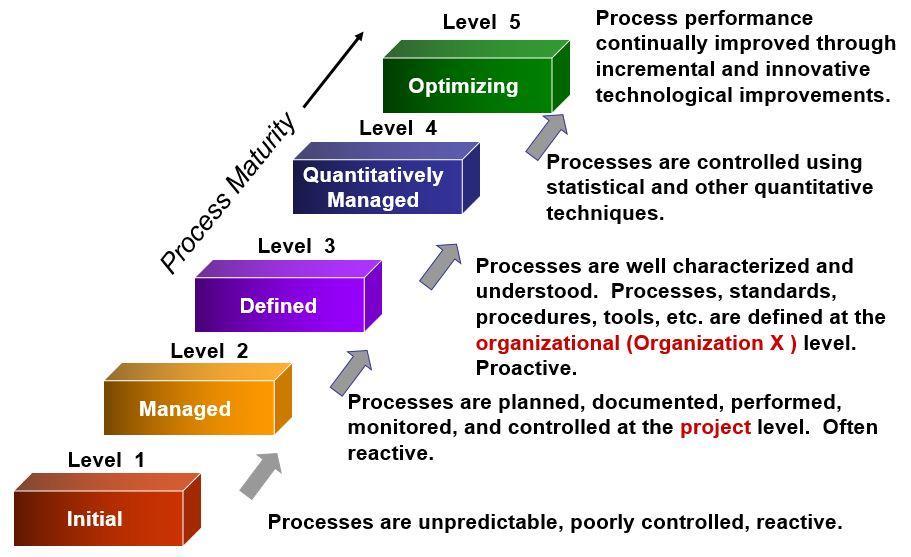
• Reputational.
• Technological (development, disruption, functionality, cyber security).
• Financial (e.g. interestrates, foreign exchange rates, funds and credit, counterparty risk).
• Political.
• Policy.
• Process.
• Engineering.
• Design.
• Partnerships.
• Collaborations.
• Human resource risk. Infrastructure. Communications.
• Supply chain.
• Disasters and events.
• Publichealth risk.
• Cultural barriers (Strauss and Corbin, 1998; Hillson, 1997).
Current and emerging factors which influence risk:
• Changingorganisational structures,governance,processes and procedures.New policy developmentand implantation. Changinglegal and regulatory requirements (e.g. ISO Standards,health and safety standards).
• Corporate Social Responsibility and sustainability.
• Short-term and long-term resource availability (e.g. people and assets).
• Changes in business continuity (e.g. business strategy). Changes to the external environment.
• Market change.
• Competition. New opportunities and challenges. New learningand developmentrequirements.
• Changingstakeholder expectations and influence.
• Purpose, governance (e.g. public, private, third sector).
• Legal status of the organisation. Organisational structure (e.g. authority versus autonomy).
• Current processes, policies, procedures.
• Organisational culture.
• Type (operational, local, international, global, SME’s, project/programme based, departmental and strategicbusiness unit).
• Levels of organisationalmaturity (Carnegie Mellon Maturity Index ‘CMMI’, 1990).
• External environment. Stakeholder influence, needs and expectations (e.g. pressure, lobby groups). Role of Regulatory bodies.
• Risk register management process (e.g. risk prioritisation, escalation, mitigation, avoidance, risk transfer).
• Use of insurance policies.
• Continuity, contingency planning.
• Disaster recovery.
• Risk prevention and monitoring.
• Shadowing competitorrisks.
• Identifying barriers and constraints.
• Approaches to problem solving.
• Messy Wicked Problems (Ackoff, Rittel and Webber, 1990).
• Tame Problems (Rittel and Webber, 2000).
• SystematicBoundary Critique (Ulrich, 1996, 2000).
• Multi Perspectives Analysis (Lindstone, 1993).
• Dealing with open and closed systems.
• Strategies to measure, manage, monitor and report risk.
• Tools and techniques (e.g. RAID logs, Gantt Charts, KPIs).
• Risk assessment, registers and mitigation. Decision-makingmodels (e.g. Ethical decision making.
• The rational model (Simon, 1979)).
• The model of bounded rationality (Simon, 1979).
• The incrementalistview (Lindblom, 1959).
• The organisational proceduresview (The political view, March, 1988).
• Financial Risk Analysis focus in analysingproblems thatan organizationcan face in the its daily operations, most specifically when the operation of the business is disrupted due to physical adversities or even economic or financial factors.
• Four main Types of Risks
Compliance – Risks from compliance with rules and regulations from industry sector, political or economical.
Strategic – Risks related with operationin a particular industry which are in a transactionperiod due to merging or other type of structural change.
Financial – Risks related to the daily financial operations, which includes business transactions and cash flow of an organization.
Operational – Risks that an organization can have from their own internal policies and methodsof operational.
Risk mitigation can be called risk reduction since creates a system to reduce the exposure of risks and likelihood of their occurrence for an organization.
The main strategies for risk mitigation are risk avoidance, acceptance, transference and limitation.
• Avoid: risk should be cancel if that involve a high impact in financial loss and damage for an organization.
• Transfer: Risks that have a reduce percentage of occur but would have a high financial impact in the organization. Purchase of insurance or outsourcing are different ways to mitigate the risk.
• Accept: When the costs of reducing the risk is higher than the risk itself. It is possible to accept the risk and create controls and monitor the risk.
• Limit: In this risk, an organization businesses create regulation to follow in case a possible risk happen and monitor the risk and system implemented.
• Root Cause Analysis (RCA) is a structured problem solving method. The aim of RCA is to identify, understand and solve the deeper 'root causes' of problems. RCA is built on the principle that causal relationships existfor all events. ... It is also universal in that it can be applied to any problem,in any sector.
• In science and engineering, root cause analysis (RCA) is a method of problem solving used for identifying the root causes of faults or problems.
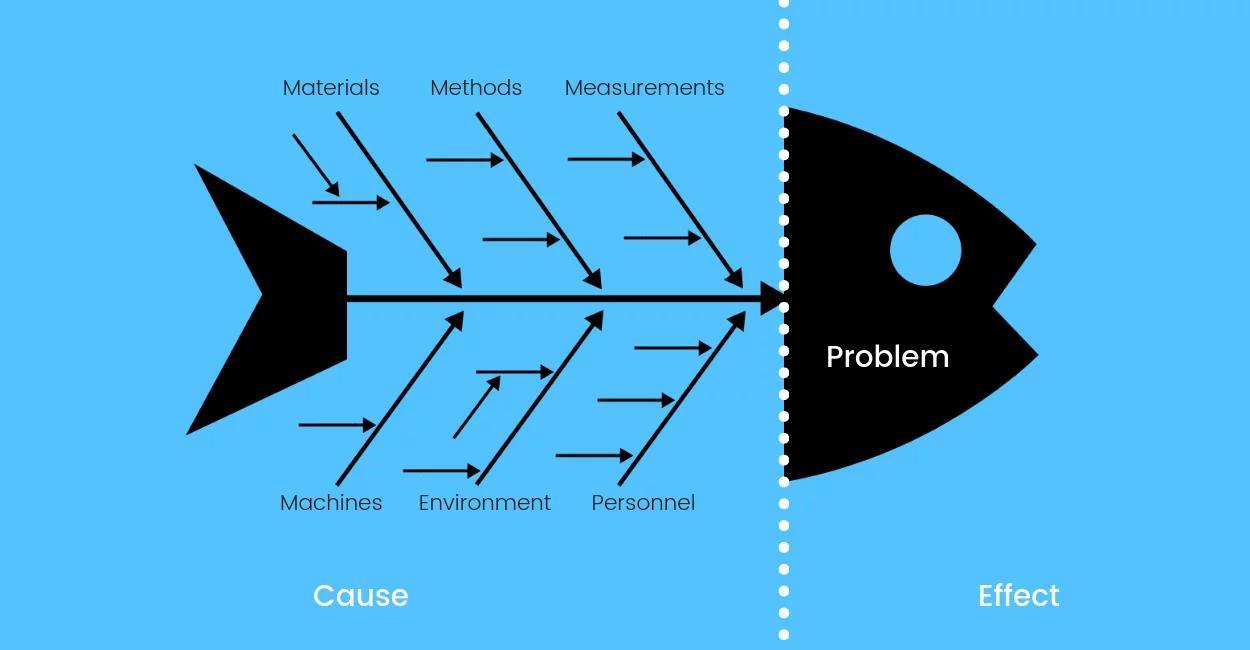
• Conflict can be seen as a series of decision-making cycles.
• In the simplest format, we observe a threat, orientate ourselves to deal with it based on a mental model that is constructed from our experience, make a decision and do something. This then starts again as our action changes the situation.
• The faster that you can cycle through this loop, the more control you will exert on a given situation. The reason for this is that the faster you make decisions, the more control you have over the environment.
• By the time you opponent is starting to act, you have changed the environment by doing something to it.
• This causes your opponent to panic as they loose control of the situation – and it is compounded the faster you cycle through the OODA Loop. A panicked opponent is one that will freeze and can therefore be defeated with little cost to you.
• That’s the simplest explanation of the OODA Loop.

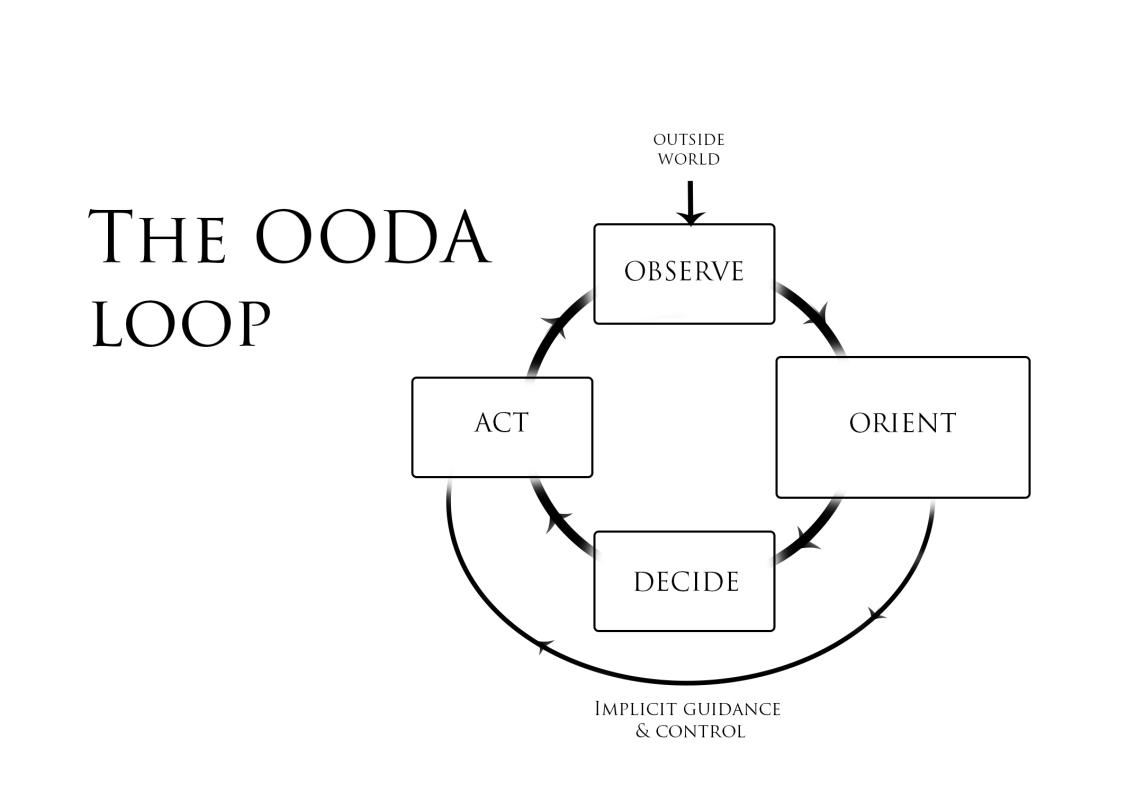
• There arefivecomponents to the framework for structured problemsolving.
• Understand the problem. This is themost importantstep in assessing theextent of the problem. By identifying thesymptoms, root causes, impacts, and significance, you painta pictureon relevanceand why the company should care.Withouttheunderstanding, itis difficultto assess how much effort the company should devoteto solvethe problem.
• Determine the solution requirements. The requirements establish thecriteria for thesolution.Subjectto the availability of resources, thedepth of a solution varies thelevel of automation and howeloquent itperforms the task. The segregation of the must-haves and nice-to-haves provide choices when determining where to investthe capital.
• Articulate options. The options mustsatisfythecorerequirements and address themost significantconcerns.Keep an open mind in developing the options. Consultthecustomers, partners, and subjectmatter experts for an objectiveand impartial viewon howthings could bedone better.
• Evaluate options. In order to do a proper evaluation of theoptions, there needs to be a well -defined listof assessmentcriteria.This listcomprises all thefactors thatwould beconsidered in comparing theoptions. These factors includecapital investment, effort, return on investment, timeliness, and others that tieto the solution requirements.Often, weights areassigned to reach therelativeimportance.
• Select a solution. The final choiceof a solution is madewhen the proper evaluation is complete.It is importantto note thatboth the quantita tive and the qualitativeanalyses need to be considered.Regulatory requirements thatmustbe met would take priority.The decision maker needs to consider all thepertinent information and selecta solution bestsuited for the problem.
• A structured problem-solving approach places thefocus on facts, issues, and solutions. This minimizes thetendency to play poli tics andcoercion for support.Italso promotes consistency when comparing alternatives in across thecompany.
• The Six ThinkingHats is a role-playingmodel presented by. It serves as a team-based problem solving and brainstormingtechnique that can be used to explore problems and solutions and uncover ideas and options that might otherwise be overlooked by a homogeneously thinkinggroup.
• De Bono's Six Thinking Hats is a powerful technique for looking at decision making from differentpoints of view. It allows emotion and skepticism to be broughtinto what might normally be a purely rational process,and it opens up the opportunity for creativity within decision making.
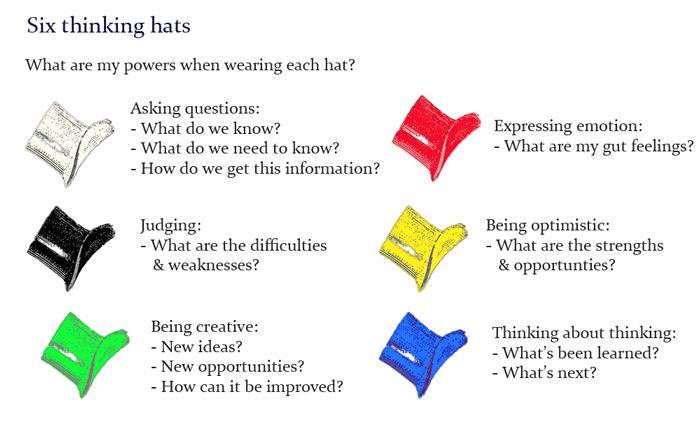
• "... decision making is the most important part of administration and the outcome of decisions depend on the process that is used in making decisions [...] bounded rationality is simply a process model that corresponds with the real world practical decisionmaking process (Kalantari, 2010)."
• The concept provides a review of the practical decisionmaking process and explores the model’s strengths, limitations and implications by comparing it to the rational behaviour model.
• There are two primary models or theories for decisionmaking: the Rational model and the Bounded rationality model. In the former, a decision-maker attempts to optimise the decision by selecting the best possible alternative. In the latter, rationality of individuals is limited by the information they have, cognitive limitations and time constraints (Kalantari, 2011).
• "In pursuing the goal of improving decision making, many different types of computerised DSS have been built to help decision teams and individual decision makers (Arnott and Pervan, 2008)."
• The concept explains the usefulness of decision support systems for organisational problem solving. It describes the types of decision support systems available, their advantages and limitations, as well as real case studies of firms using DSS across different industries and sectors.
• Decision Support Systems Definition
• Decision Support Systems (DSS) are interactive computer-based systems that enable people to use IT communications, data, documents, knowledge and models to solve problems and make decisions. DSS are intended to improve and speed-up the processes by which people make and communicate decisions. However, they are designed to be auxiliary systems instead of replacing skilled decision makers (Power, 2002).
• "Decision trees can assist executives in makingstrategicdecisions (Buckley and Dudley, 1999). "
• The concept describes one of the most used decision-makingmodels, a decision tree, which explores all possible decisionsand their consequences and allows for comparison of such alternativesin one single pane.
• A decision tree is an analytical tool for partitioninga dataset based on the relationships between a group of independentvariables and a dependent variable (Coles and Rowley, 1995). It is a pictorial representationof the flow of events in a logical and time-sequenced manner so that the decision-maker can consider the probabilities of each outcome (Marsh, 1993). In other words, it is a decision support tool thatuses a tree-like graph or model of decisions and their possible consequences, such as chance event outcomes, resource costs, and utility.
• Decision-making is oneof the most crucial challenges for managers.Aglobal survey of CEOs cited by John Adair found thatthe ‘ability to take decisions’ was rated as themost importantof 25 attributes required by senior managers.
• The way in which decisions aremadewill beinfluenced by an organisation’s structure, procedures and policies, and moresubtly by its cultureand politics.Itshould also depend on the natureof the decision, for examplethelevels of uncertainty involved, whether a crea tiveor technical approach is needed, and how many peopleare involved.
• One well-known method for making decisions on specific issues was developed by Charles Kepner and BenjaminTregoein their book "The Rational Manager" published in 1965.
• Their research was based on their observations atRAND Corporation of howair forcemanagers madedecisions. They realised thatwhilefew were ableto articulatetheir decision-making process, thosewho madebetter decisions could beseen to followmorelogical processes .
• Kepner and Tregoe’s rational model can bean effectivetechniquefor determining a courseof action and securing commitmentto it. It is most suitablewherea straightforward and technical approachis needed, rather than where creativethought is desirable.
• The model assumes thatyou can access all of the informationyou will need to make the decision.Itrequires that:
• a singlegoal and clearoptions can bedefined
• preferences areunambiguous and constant
• there is a high level of certainty aboutoutcomes.
If used in the right circumstances, this model has several advantages over processes based on intuition. The rational model:
• takes a thorough and systematicapproach
• aims to be impartial and transparent
• provides evidence and support for how the decision was made
• relies on effective information-gathering, rather than preconceivedideas
• prevents managers from being distracted by their emotionalresponses
There can, however, be drawbacks, because the method:
• can be very time-consumingand resource-intensive, especially in fast-movingsituations
• relies heavily on informationwhich may prove difficult to gather
• requires fairly strict adherence if the outcome is to be a rational decision
• leaves little room for intuition or lessons learned from past experience
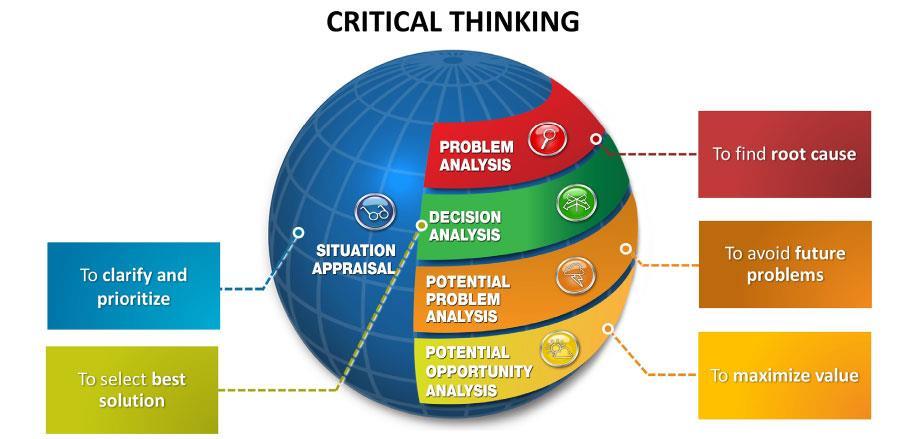 Charles Kepner and Benjamin Tregoe
Charles Kepner and Benjamin Tregoe

• 1. Identification of problem
• 2. Identification of Decision Criteria
• 3. Allocation of weights to criteria
• 4. Development of alternatives
• 5. Analysis of alternatives
• 6. Decide on an alternative
• 7. Implementationof decision
• 8. Evaluationof decision
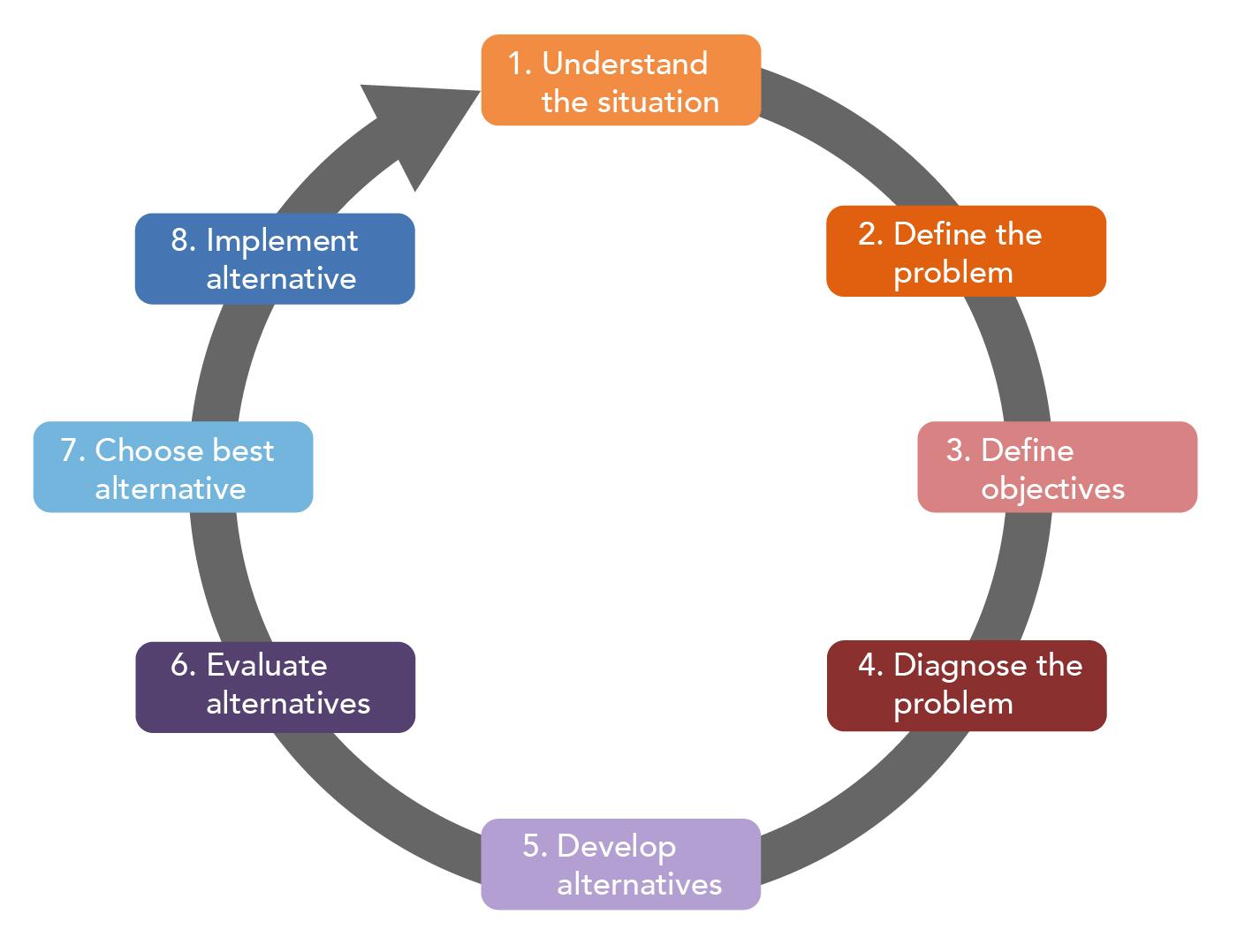

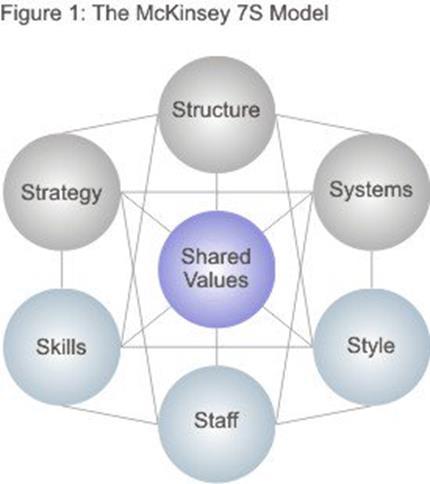
• How do you go about analysinghow well your organization is positioned to achieve its intended objective?
• Some approaches look at internal factors, others look at external ones, some combine these perspectives, and others look for congruence between various aspects of the organizationbeing studied
• While some models of organizationaleffectiveness go in and out of fashion, one that has persisted is the McKinsey 7-S framework. Developed in the early 1980s by Tom Peters and Robert Waterman, two consultants workingat the McKinsey & Company consultingfirm, the basicpremise of the model is that there are seven internal aspects of an organization thatneed to be aligned if it is to be successful.
• The McKinsey 7-S model involves seven interdependent factors which are categorized as either "hard" or "soft" elements:
"Hard" elements are easier to define or identify and management can directly influence them: these are strategy statements; organization charts and reporting lines; and formal processes and IT systems.
"Soft" elements, on the other hand, can be more difficult to describe, and are less tangible and more influenced by culture. However, these soft elements are as important as the hard elements if the organization is going to be successful.
It can be used in a wide variety of situations such as improve the performance of a company, examine the likely effects of future changes within a company, align departments and processes during a merger or acquisition and determine how best to implement a proposed strategy.
There is an interdependency of the elements and indicates how a change in one affects all the others.
• Strategy: the plan devised to maintain and build competitive advantage over the competition.
• Structure: the way the organization is structured and who reports to whom.
• Systems: the daily activities and procedures that staff members engage in to get the job done.
• Shared Values: called "superordinate goals" when the model was first developed, these are the core values of the company that are evidenced in the corporate culture and the general work ethic.
• Style: the style of leadership adopted.
• Staff: the employees and their general capabilities.
• Skills: the actual skills and competencies of the employees working for the company.
• The McKinsey 7-S model is one that can be applied to almost any organizational orteam effectiveness issue. If something within your organization orteam isn't working, chances are there is inconsistency between some of the elements identified by this classic model. Once these inconsistencies are revealed,you can work to align the internal elements to make sure they are all contributing to the shared goals and values.
• The process of analysingwhere you are right now in terms of these elements is worthwhile in and of itself. But by taking this analysis to the next level and determining the ultimatestate for each of the factors, you can really move your organization or team forward.
Track Description
Culture Track
The culture trackconsists ofa five step process: (1) surfacing actual norms, (2) articulating what is needed for success today, (3) establishing new norms, (4) identifyingculture-gaps, and (5) closing culture-gaps. The culture track first exposesthe old culture and then, if necessary, createsa newadaptive culture.
Skills Track
The skills trackis needed because employees usuallyhave not kept up with the holographic world in which theylive and its d ynamic, complex problems. Theyoften have not developed the skills conceptual, analytical, administrative, social, and interpersonal to manage complexity. The skills trackalso offers a systematic method for uncovering the underlying assumptions that drive all decisions into action.
Team Track
As the culture and skills tracks are encouraging new behaviors, skills, and assumptions, the next effort lies in directlytra nsferringthese learnings into the mainstream of organizational life. Specifically, the teamtrackdoesthree things: (1) keeps dysfunctional behavior in check so negativitywill not disrupt cooperative team efforts, (2) brings the new learnings into the day-to-dayactivities ofeach work group, and (3) enablescooperative decisions to take place acrossworkgroup boundaries, as in multiple team efforts.
Strategy-Structure Track
Reward Track
The strategy-structure track is conducted in an eight step process: (1) makingstrategic choices, (2) listing objectives to be achieved and tasks to be performed, (3) analyzing objective/task relationships, (4) calculatinginefficiencies that stem froman out-of-date structure, (5) diagnosing structuralproblems, (6) designing a new structure, (7) implementing the new structure, and (8) evaluatingthe new structure.
Once the organization is moving in the right direction with the right structure and resources, the reward system track completesthe program bymaking sure that rewards varydirectlywith performance. The formalsystem is designed via a seven step process: (1) designing special taskforces to studythe problem, (2) reviewing the types of reward systems, (3) establishing severalalternative reward systems, (4) debating the assumptions behind the alternative reward systems, (5) designingthe new reward system, (6) implementing the new reward system, and (7) evaluating the newreward system.
• The five tracks to organizational success constitute a completely integrated program. Each track is implemented as a collaborative, participative effort among managers, consultants, and members.
The Congruence Model was developed in the early 1980s by organizational theorists David A. Nadler and Michael L. Tushman.
It's a tool for identifying the root causes of performance issues. It can also be used as a starting point for identifying how you might fix them.
It's based on the principle that a team or organization can only succeed when the work, the people who do it, the organizational structure, and the culture all "fit" together – or, in other words, when they are "congruent"

Where there is incongruence, or a poor fit, between these four critical elements, problems will arise.
You can have the latest technology and processes, but decision making will be slow and problematic if the organizational culture is bureaucratic.
Work refers to the tasks carried out by employees. It’s important that the result of these tasks are aimed at the company objectives. It should be apparent which skills or knowledge are required for tasks and company activities, and these should be present to a sufficient degree within the organisation.
People are an important part of the organisation and the congruence within it, and form an important part of the Nadler-Tushman Congruence Model. A company aimed at innovation is looking for pioneering, fast-thinking people. A sales company is mostly focused on finding sales talent. It should be known of employees which skills and knowledge they possess, whether they have experience, and what education they have followed. It should also be known how they would like to be individually rewarded and compensated for their work. For motivated staff, it’s also important that they should be able to develop potential within themselves.
Although aligning the work from the first of the four elements is important, aligning the organisational structure is even more important. Structure is the third component of the Nadler-Tushman Congruence Model. It creates consistency between what an organisation wants and what it does. A company that responds to new market developments needs a flexible corporate structure that is able to quickly adjust to the changing market. A company chain with outlets in various regions would benefit more from a hierarchical structure with regional managers.
The corporate culture consists of values and norms, behavioural patterns and rules, both written and unwritten. The corporate culture also has great influence on the wayit supports and stimulates the corporate results. Sometimes, an organisation’s culture needs to change before the organisation is able to adjust to a new business focus. A relaxed, informal corporate culture may work well for a startup, but will need to become somewhat more mechanical upon growth. There are also organisations where the focus is on employees and their well-being. This happens in altruistic organisations
• The Congruence Model is also a useful tool for thinking through how changes you make within a team or organization will impact upon other areas.

To apply the Congruence Model, look at each component and then analyse how they relate to one another.
1. Analyse Each Element
2. Analyse the Relationships Between the Elements
3. Build and Sustain Congruence
It doesn’t tell you how to fix those problems.
It doesn't recommend a "best" culture or "best" structure, nor any specific action plans or problem-solvingtechniques. You'll need individual toolsto help you here. Task Allocation, for example, can help you to pair the right people with the right work. And Organization Design is an effective approach for aligningwork and structure.
Emphasises the importance of achieving"fit" between the elements, and of organizing them in a way that supports your strategy.
Focuses mostly on the internal environment – it's often importantto consider what's happeningoutside the team or organization. (Tools such as PEST Analysis and PMESII-PT can be useful here.)
Six Sigma actually has its roots in a 19th Century mathematical theory, but found its way into today’s mainstream business world through the efforts of an engineer at Motorola in the 1980s. Now heralded as one of the foremost methodological practices for improving customer satisfaction and improving business processes, Six Sigma has been refined and perfected over the years into what we see today.
No matter what the setting is, 6 sigma aim is to improve business process by removing the causes of the errors that has led to defects in their products or service.
Define the problem and the project goals
Measure in detail the various aspects of the current process
Define the project goals
Measure critical components of the process and the product capabilities
The two major methodologies used within six sigma, both of which are composed of five sections.
Analyze data to, among other things, find the root defects in a process Improve the process
Control how the process is done in the future.
Analyze the data and develop various designs for the process, eventually picking the best one
Design and test details of the process
Verify the design by running simulations and a pilot program, and then handing over the process to the client
DMAIC: Existing Company DMADV: New Company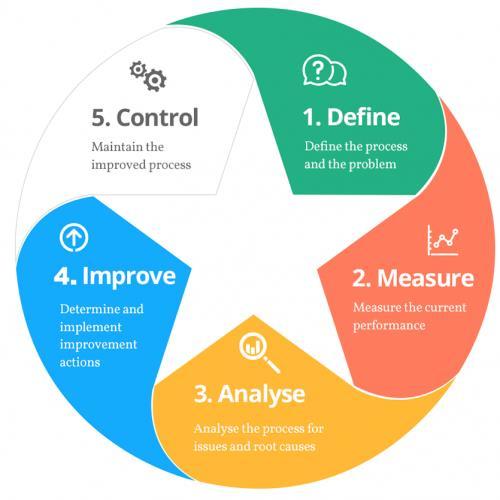
• Jay Galbraithdevelopedhis "Star Model™" framework for analysingorganizations in the 1960s. The Star Model™ is the foundationon which a company bases its design choices. The framework consists of a series of design policies that are controllable by management and can influence employee behaviour. The policies are the tools with which management must become skilled in order to shape the decisions and behaviours of their organizations effectively.
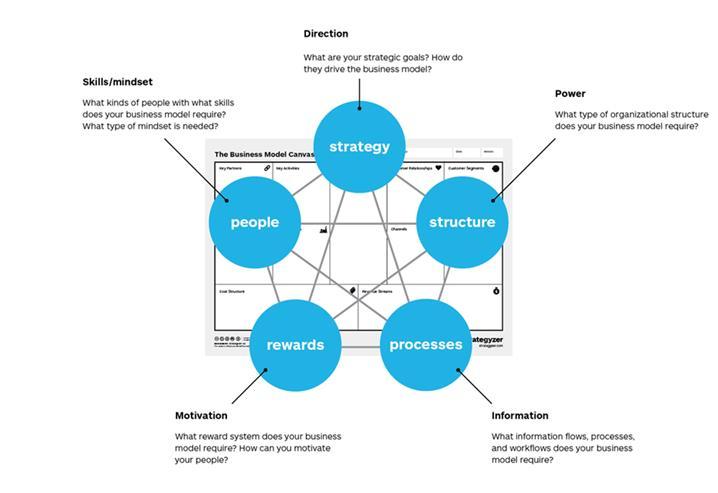
• In the Star Model™, design policies fall into five categories. The first is strategy, which determines direction. The second is structure, which determines the location of decisionmaking power. Processes have to do with the flow of information;they are the means of respondingto information technologies. Rewardsprovide motivationand incentives for desired behaviour. And finally, the selection and development of the right people — in alignment with the other policies — allow the organizationto operate at maximum efficiency.
• The Star Model™ shows the levers that managers can control, and as a result, can affect employee behaviour. By choosing the desired behaviour, managers can influence the organization's performance as well as its culture.
• Strategy
• An organization's strategy is defined by its vision, mission, and values as well as its goals and objectives. Strategy sets out the direction of the organization. It comes first in the Star Model because it establishes useful criteria for making trade-offs and choosing among alternative options in the remaining four elements or organizational design.
• Strategy drives the business model. If you want to grow by 20% in new market segments then it should be reflected in your business model in terms of new Customer Segments, Channels, or Key Activities.
• Structure
• An organization's structure determines the type and number of job specialties needed as well as decides the number of departments and people in each department. It dictates the placement and movement of power and authority, and is the basis for forming departments. Organizational structures can be highly centralized or decentralized.
• The characteristics of the business model determine the optimal organizational structure for its execution. Ask yourself, "What type of human capital will the model require? What activities will those people need to perform? How should the structure be formed to accommodatethose needs?"
Galbraith Star Model Galbraith Star Model• Process
• Organizational processes are defined by the flow of information and decisions. Those flows can happen vertically or horizontally. Vertical processes deal with allocating funds and talent via budgeting and planning. Horizontal processes are designed around workflow and are carried out through lateral relationships between departments.
• Each business model demands different processes. Lean, highly automated processes should be inherent to a low-cost business model. Rigorous quality control processes might be required if your business model involves selling high value machines.
• People
• An organization's human resource policies govern recruitment, promotion, rotation, training and development. Those policies are designed to produce the talent and build the capabilities necessary to execute the strategic direction of the organization. They must be in harmony with the other design areas.
• Certain business models call for people with particular skills and mindsets. Some business models rely on entrepreneurial mechanisms for regularly bringing new
• Reward systems align the goals of employees with the goals of the organization. The system must use appropriate incentives to motivate workers to do the right things to fulfil the strategic direction of the organization. The reward system must be congruent with the other design areas to influence strategic direction.
• Different business models require different reward systems. If your business model depends heavily on customer satisfaction then your reward system should reflect that commitment. If your model requires a direct sales force to acquire new customers then your reward system should be highly performance oriented.
GalbraithA framework developed by Marvin Weisbord, this model is one that can help you to accurately assess the functioning of your organization. One of the advantages of using this specific model is its ability to adapt to just about any business that you happen to be in.
Weisbord suggests you ask yourself a set of questions for each area being examined. The aim of this process is to reveal information you previously were not aware of, and subsequently expose possible areas of weakness. Below we have summarised a few of the key questions Weisbord suggests you ask for each area of investigation.
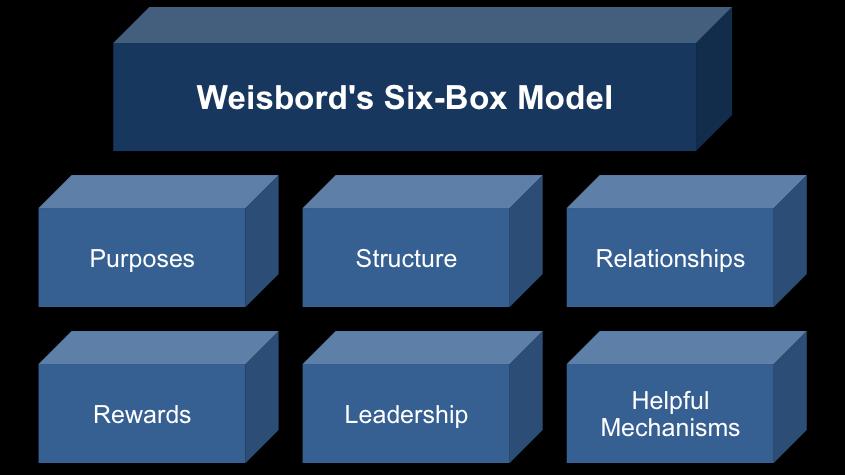
Acknowledging the main mission and vision of the organisation and asking yourself how well the goals it sets itself and its employees are understood is a good first step. Then assessing how well these goals fit with your organisation’s competencies may reveal why it is not operating at maximum efficiency. The setting of these goals is also important, every employee should not only be aware of them, but also contribute to their design.

Firstly, determine the nature of your organisational design, who reports to who and who does what. This can then be aligned with the processes of the organisation to determine how well they are being supported. More specific questions, about communication pathways for example, can then be asked to determine how efficient these processes are.

This section explores team dynamics, communication and collaboration occurring within the organisation. A lack of communication between different departments is often an invisible cause of many issues.

The incentive mechanism is very important for determining employee performance and can often be a key cause in organisational issues. It is not only important to assess how employees are being rewarded, but also what work is being rewarded. Generous reward systems may exist, yet some employee’s achievements may be consistently ignored. This lack of recognition can lead to resentment and demotivation.
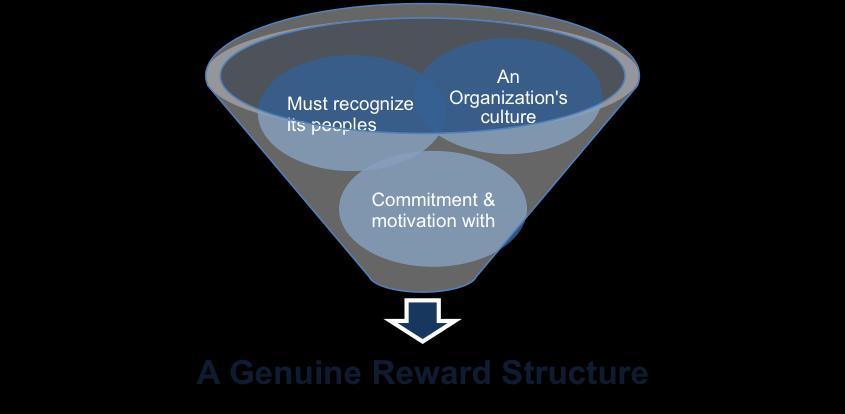
It is the job of the organisation’s leaders to ensure all these elements are running properly, as well as making sure the correct balance is struck between them. They are also responsible for resolving any internal conflict that may be occurring. Weisbord suggests asking who these leaders in the organisation are, how they have got there and how effective they are at the tasks they are responsible for.

Assessing the communication pathways, policies and procedures and planning, budgeting and controlling systems for organisational processes can often reveal areas of inefficiency. Weisbord’s 6 box model is not going to solve all of your organisation’s underlying issues, but it is an excellent tool for starting the process. It is a logical and practical tool for investigating all the key areas of the business for possible weaknesses.

• Business process re-engineering(BPR) is a business managementstrategy, originally pioneered in the early 1990s, focusingon the analysis and design of workflows and business processes within an organization. BPR aimed to help organisations fundamentally rethink how they do theirwork in orderto improve customer service, cut operational costs, and become world-class competitors.
• BPR seeks to help companies radically restructure their organizations by focusingon the ground-up design of their business processes. Accordingto early BPR proponentThomas H. Davenport(1990), a business process is a set of logically related tasks performed to achieve a defined business outcome. Re-engineeringemphasized aholisticfocus on business objectives and how processes related to them, encouraging full-scale recreation of processes rather than iterative optimization of sub-processes.
• Business process reengineeringis also known as business process redesign, business transformation, orbusiness process change management.
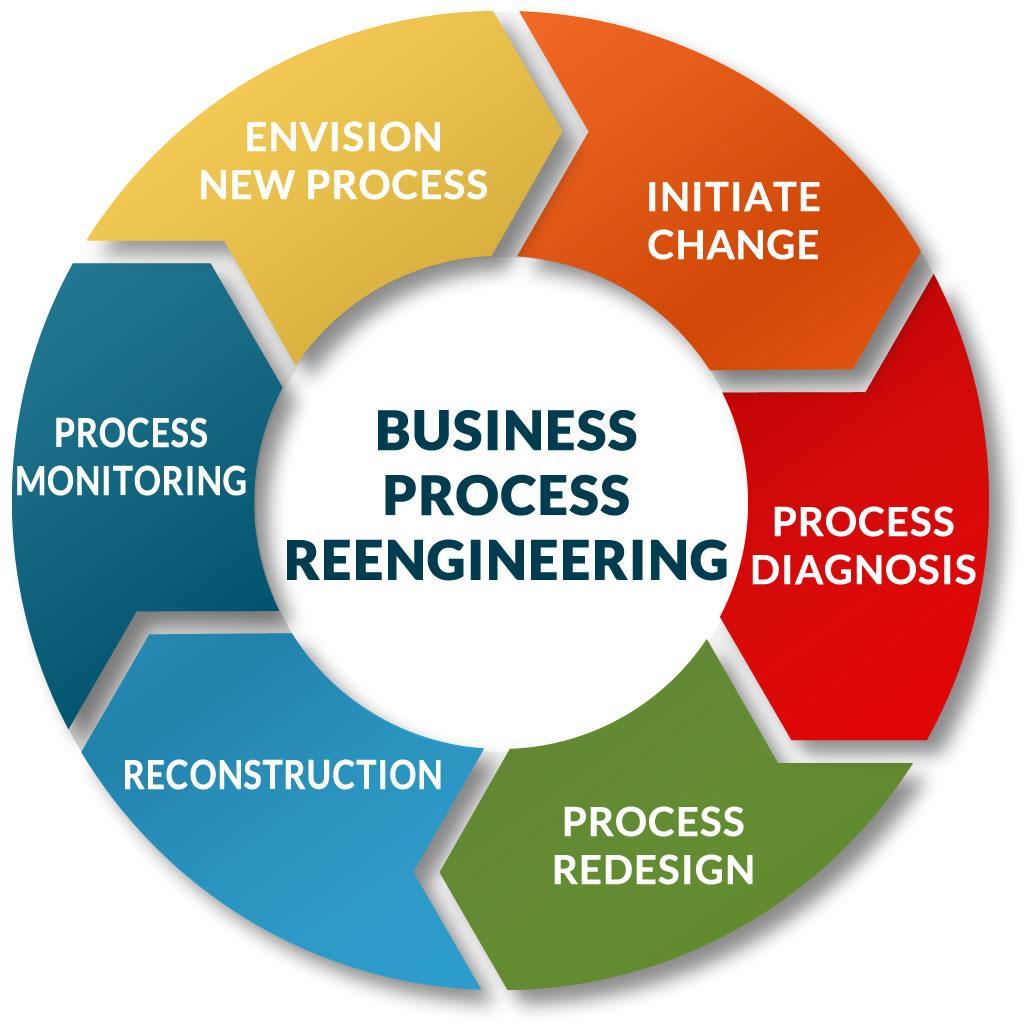
Reengineering initiatives lead to an organisation having these characteristics:
Business processes are simplified
Job descriptions expand – employees perform a broader range oftasks
The emphasis moves away from the individual and towards teamachievements
The organisation structure changes from a hierarchy to a flatter arrangement
The focus of the organisation becomes professionals, not themanagers
The organisation becomes aligned with end-to-end process rather than departments
Performance measurement moves away from activity towards results
Employee focus changes from pleasing their manager to pleasing the customer
The organisation value system changes from being protective to being productive
Successful reengineering programs have these common themes:
The focus is on processes rather than organisational boundaries
The ambition to create performance gains
A willingness to break with old traditions and rules
To succeed at reengineering, follow these principles:
Start with the customer and work backwards
Tolerate risk and accept flaws along the way
Design work processes in light of organisational goals
Restructure to support front-line performance
Remember that reengineering is the opposite of business as usual
8. Ongoing continuous development
1. Develop vision & objectives
7. Evaluate the new process
2. Understand existing processes
Business Process Reengineering
6. Make new
process operational
3. Identify process
for re-design
5.Implement the new process
4. Identify change levers
Dr. Lawrence G. Hrebiniak is an Emeritus Professor in the Department of Management at the Wharton School of the University of Pennsylvania and a member of the Strategy Group. He has written widely on the subject of strategy and in particular on the implementation of strategy. Based on his own research, this model provides an overview of the interdependent organisational components which need to interact with each other in order to successfully implement corporate strategy.
These are:
Corporate Strategy:
Which is concerned with the whole organisation and the business units within it.
Business Strategy:
Which focuses on products, services and short-term operating objectives.
Corporate Structure: Across the whole organisation.
Business Structure:
In the individual business units.
Incentives and Controls:
To ensure that individuals put organisational strategy into practice.
Corporate Strategy
Corporate Structure/ Integration
Business strategy and short-term objectives
Business Structure/ Integration
Incentives and Controls
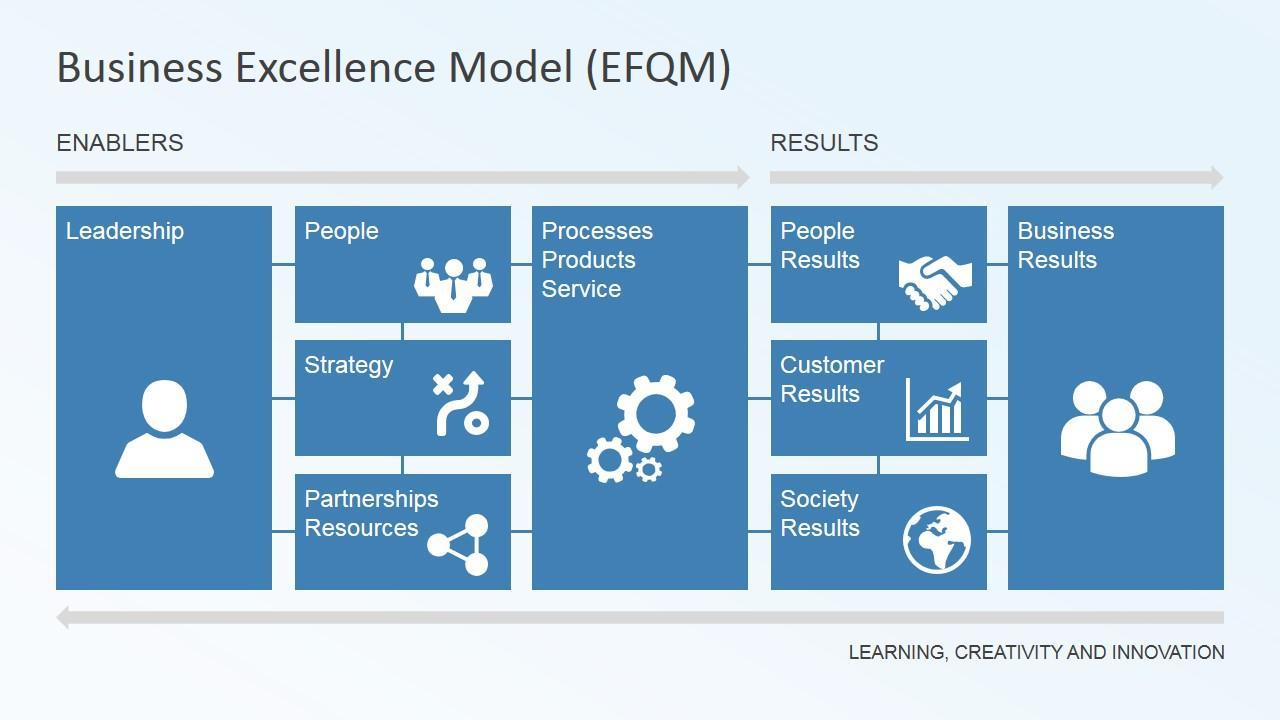
• The EFQM excellence model is a non-prescriptive business excellence framework fororganizational management, promoted by the EFQM and designed to help organizations to become more competitive.
• Regardless of sector, size, structure or maturity, organizations need to establish appropriate managementsystems to be successful. The EFQM excellence model is atool to help organizations do this by measuringwhere they are on the path to excellence, helpingthem understand the gaps, and promotingsolutions.
• A numberof research studies have investigated the correlation between the adoption of holisticmodels such as the EFQM excellence model, and improved organizational results. The majority of such studies show a positive link. One of the most comprehensive of these was carried out by Vinod Singhal of the Georgia Institute of Technology and Kevin Hendricks of the College of Williamand Mary.
• The EFQM model provides a framework allowingorganisations to determine theircurrent "level of excellence"and where they need to improve theirefforts. The model also helps to ensure that business decisions incorporate the needs of all stakeholde rs and are aligned with the organisation's objectives.
• The EFQM model acts as a common reference. Itprovides its users with a set of performance improvementtools in order for them to achieve and sustain business success. The model is regularly reviewed to incorporate new ideas, concepts and learning. The last revision was published in 2013.
• The EFQM model is used to obtain a complete view of the organizational performance and to understand the relations of cause and effects between whatorganisations do and the results they achieve.
• Components
• The model consists of three components:
• Eight core values or key management principles that drive sustainable success
1. Adding value for customers
2. Creating a sustainable future
3. Developing organisational capability
4. Harnessing creativity and innovation
5. Leading with vision, inspiration and integrity
6. Managing with agility
7. Succeeding through the talent of people
8. Sustaining outstanding results
• Nine criteria, separated into five "enablers" (leadership, people, strategy, partnerships and resources, and processes, products and services) and four "results" (people, customer, society, and business results)[
• RADAR logic, continuous improvementcycle used by EFQM.
• It was originally derived from the PDCA cycle.
• Determine the Results aimed at as part of the strategy
• Plan and develop a set of Approaches to deliver the required results now and in the future
• Deploy the approaches in a systematicway to ensure implementation
• Assess and Refine the deployed approachesbased on monitoringand analysisof the results achieved and ongoinglearning

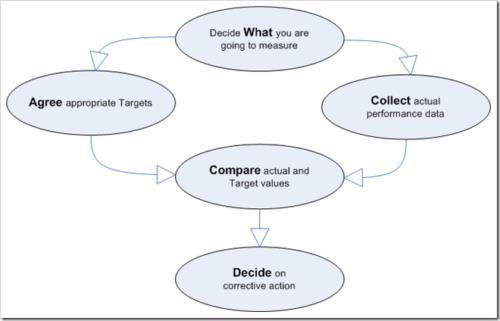

"The things we fear most in organizations– fluctuations, disturbances, imbalances – are the primary source of creativity (Margaret J. Wheatley)"
Continuous improvementstrategy has been mostly applied in the field of quality improvement. The concept reviews initiatives thatenhance operational performance and reports on research in the area highlightingkey success factors, capabilities and business evidence.
The term continuous improvement(CI) is derived from the Japanese management concept Kaizen. It is a process of constantly introducingsmall incrementalchanges in a business in order to improve quality and/or efficiency. Bhuiyan and Baghel (2005) define CI more generally as a culture of sustained improvement targetingthe elimination of waste in all systems and processes of an organisation. It involves collective workingto make improvements withoutnecessarily makinghuge capital investments (Bhuiyan and Baghel, 2005).
• A Kaizen event, or blitz, is a set of specific actions taken with clearly defined goals for improvement. They are small steps; simple, planned actions taken by a group of workers to effect process improvement. A Kaizen event is alternatively called a “blitz” because that term describes its rapid pace to conclusion.
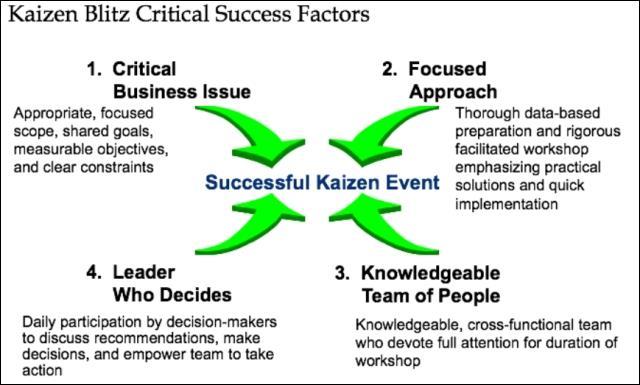
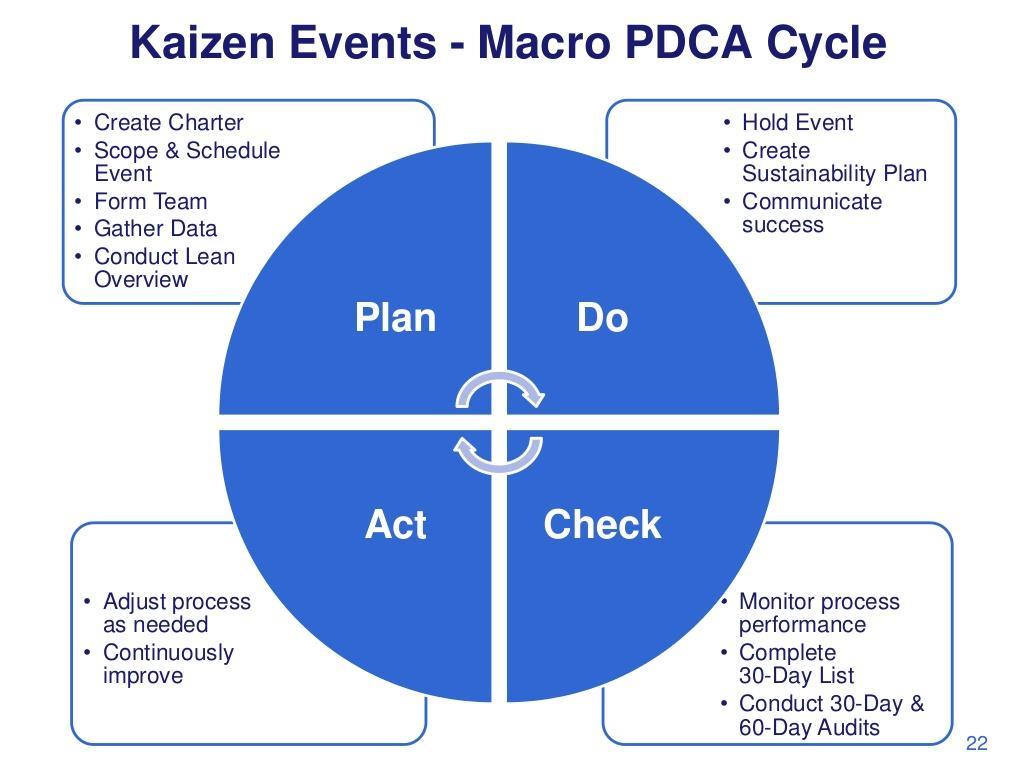
"Balance Sheets present lists of items, grouped by category. The lists are additive. For example, the sum of all the listed assets is total assets (Stickney et al., 2009)."
The balance sheet provides a good picture of the financial health of a business and is a tool used to evaluate liquidity. The concept helps small business owners, managers and practitioners to quickly grasp this financial term and to understand and identify the strength and capabilities of the balance sheet.

The Balance Sheet shows the financial position of a company at a particular moment in time, such as the end of the financial year. It lists the company's assets, liabilities and equity capital (Chisholm, 2010). The Balance Sheet provides a snapshot of company assets and the sources of money that was used to buy those assets. The items in the Balance Sheet are listed in declining order of liquidity (Brealey and Myers, 2003).
"“Automating the current budgeting process with software relieves much of the workload and frustrationin the finance department but does little for the line manager and ultimately little for the organization as a whole” (Barrett, 2007)."
This concept describes purposes and uses of budgets in organisations and identifies stages of the 'traditional' budgeting process. It also describes some of the benefits of effective budgeting and assesses some of its limitations.
The budgetingprocess can be defined as a systematicbusiness activity that encompassesthe development, implementation and evaluation of a plan for the provisionof services and capital assets includingfixed resources, such as money or time, duringa given period to achieve desired financial targets (Tracy, 2008). In other words, budgetingprocess is the allocationof capital which is then used in the proper way to achieve the set or designated targetsof the firm.
"Break-even analysis is a particular example of the more general technique of cost-volume-profitanalysis. This analysis emphasizes the relationship between sales, revenue, costs and profit in the short term (Weetman, 2006). "
Cost-volume-profit (CVP) analysis is used to determine how changes in costs and volume affect a company's operatingincome and net income. This concept reviews strength and weaknesses of the analysis and outlines its main principles.
Cost-Volume-Profit (CVP) Analysis, also known as Break-even Analysis, is a way of understandingthe relationship between abusiness costs, the volume of good or sales they need to make and any potential profit. It is a tool for planningand decision-makingthat emphasises the interrelationships of cost, quantity sold, and price (Hansen et al., 2007). It allows managers to see the effectof changes in cost and volume on a company's profits so can be used help make decisions such as set selling prices, determine productmix, and maximise the use of production facilities. (Weygandt et al., 2009).
"In the final analysis, you get what you pay for (James Sinegal, CEO Costco)."
The concept will enable business owners, project leaders and practitioners to grasp the basics of costbenefit analysis and understandthe systematicprocess for calculatingand comparingbenefits and costs of a project.
Cost-Benefit analysis is an approach to activity appraisal thatinvolves the estimationof the overall cost and benefits in monetary value terms. The activity could be an impendingproject or proposed policy. The approach is used to determine whether a particular activity is viable or to evaluate the effects of alternative decisions (Barnett, 1985).
"Financial ratios allow the analyst to assess and analyse the strengths and weaknesses of a given company ... on an absolute basis and by comparison to other companies in its industry or to an industry standard (Hitchner, 2011)."
Financial Ratio Analysis is a useful tool for detecting the company's strengths and weaknesses - many stakeholders use it to make important decisions when it comes to investments. The concept reviews the most essential elements and applications of Financial Ratio Analysis, along with its strengths and weaknesses.
As financial statements contain a huge amount of data, financial analysts condense this data into a manageable form by calculating a small number of key financial ratios (Brealey and Myers, 2003). These ratios are classified into different types focused on different analysis perspectives - this is due to the fact that every stakeholder will have different objectives and expectations, requiring different analysis points of view (Moyer et al., 2008). The different groups are liquidity, asset management (or efficiency), financial leverage, profitability, market-based and dividend policy ratios.
"In many cases, financial statements will be serving several different roles at the same time (George Foster)."
The concept reviews the process of evaluatingand analysingcompany financial statements and provides you with an understandingof how to assess the financial health of the companyand enable more effective decision-making.
Financial statementanalysis, or financial analysis, involvesthe attempt to understand the performance outcomes and risk of a firm, sub-unit or a project, through the study of financial reports (Brealey and Myers, 1996).
"Organisations need to be aware that bias from accounting procedurescould potentially “mask” underlyingoperatingefficiency (Lucey, 2003)."
Return on capital employed is an accountingratio used in finance, valuation,and accounting. The concept explains the ratio in more details and explores how it is can be used in organisations.
Return on Capital Employed (ROCE),also termed return on investment(ROI), is the summary ratio which captures in the numerator the earnings of a company's preinterestexpenses and tax, and in the denominatorthe total capital employed calculated as interest bearinglong-term debt plus shareholder funds (Andersson et al., 2006:24).
• Arbitrage pricing theory (APT) is a method for assetpricing model based on the ideathat an asset's returns can be predicted usingthe linearrelationship between the asset’s expected return and a numberof macroeconomic variables that capture systematicrisk. It is a useful tool for analysingportfolios from a value investing perspective, in orderto identify securities that may be temporarily mispriced.
• Rational choice theory define thatinvestors use rational calculations to make rational choices and achieve outcomes that are aligned with theirown financial interests.
• Prospect theory assumes that losses and gains are valued differently, and investors make decisions based on perceived gains instead of perceived losses.
• Cumulative Prospect Theory - It is a theory or model developed fordescriptive decisions beneath uncertainty and risk. In this case the weightingis applied in case of cumulative probability and not applied in individual outcomes.
• Monte Carlo Option Model is a method where simulations are used to model the probability of differentoutcomes in a process that cannot easily be predicted market variances. It is a technique used to understand the impact of risk and uncertainty in prediction and forecastingmodels.
• The binomial option pricing model is an options valuation method developed in 1979. The binomial option pricing model uses an iterative procedure,allowingfor the specification of nodes, or points in time, duringthe time span between the valuation date and the option's expiration date.
• The Gordon Growth Model (GGM) is used to determine the basic value of a stock based on a future series of dividends that grow at a constantrate.
• The InternationalFisher Effect (IFE) is an economic theory stating that the expected variations between,the exchange rate of two currencies is approximately equal to the difference between their countries' nominal interestrates. The International Fisher Effect (IFE) states that differences in nominal interest rates between countries can be used to predict changes in exchange rates.
• Capital Asset Pricing Model – Used to calculate Asset’s rate of profit or rate of return

• Arbitrage Pricing Theory – The asset value depends on macro and company specific factors
• Modern Portfolio Theory – The ratio of each asset must be chosen and combined carefully for minimum risk and maximum return
• Value at Risk Model – Calculate the risk involved in the financial market and defines the potential loss in value of a portfolio over a definite period of time and the potential risk involved
• Jenson’s Performance Index – Calculate the abnormal return of any financial asset in comparison with its expected return in any portfolio
• Paired comparisons. If you are consideringmultiple options, pairingthem and comparingtheir performance on key requirements allows you to quickly eliminate options, allowingonly the preferred options to progress to the next ‘round’. You could then use another decision making tool to make the final choice.
• PMI – plus/minus/interestingis a kind of ‘pros and cons’ list used to make binary yes/no decisions, where you also record any interestingimplications of the choice that do not clearly fit into the ‘plus’ or ‘minus’ columns. Before you start, it is importantto ensure that a binary decision is really what you are faced with, and that you are not excludingother valid options.
• The Pareto Principle states that 20% of inputs deliver 80% of results. It can be applied and holds true in a surprisingvariety of situations. If you are aware of where this principle applies in your business, you may be able to work out which change option could deliver the greatest benefits.
‘Shortcut’ strategies, for use if time is limited or the decision is less complex, include:
Common psychological traps that can impair our decision making include:
• confirmation bias – uncritical acceptance of information that confirms existing beliefs
• false analogy – assuming that the situation is just like a previous one, ignoring the differences
• availability bias – allowing your mind to construct a narrative only from the information that is immediately in front of you
• tunnel vision – failing to see the ‘big picture’ while focusing on the detail
• vividness – ignoring more mundane alternatives in favour of the most vivid option, for example being swayed by a sales pitch into making an instant decision without considering alternatives
• sunk cost fallacy – giving weight to resources that have already been spent, when these do not have an impact on the future costs and gains of pursuing an alternative
• loss aversion – a preference for avoiding possible losses over pursuing possible gains.
• The first step to avoidingthese traps is to be aware of them, but this is unlikelyto be enough to eliminatethem.
• Including more people in the decision could help, since it is easier to spot biases in others’ thinkingthat to recognise them in your own.
Crowdsourcing techniques have been shown to reduce errors in decision making, since they allow many people to pool their knowledge on an equal footing.
• Boston Matrix A simple2 x 2 matrix thatcategorises products or businesses as ‘Stars’ (high potential);‘Cash Cows’ (matureprofitablebusinesses);‘Dogs’ (Small marketsharein mature market); and Question Marks (Uncertainty with regards to viability).
• Ansoff Matrix – Used to help understand the differencebetween new products with an existing market, such as brand extensions;newmarkets with an existing product, suchas new geographies;and genuinediversification –a new productand new market.
• Greiner’s Five Stages – Firstdeveloped in the early 1970s by Larry Greiner, and revised in the late1990s, this model describes thephases of company growth and development, and identifies themanagerial challengeateach stage.The fivestages are:Creativity, Direction, Delegation, Co-ordination, Collaboration.Greiner later suggested a sixth stage, relating to extra-organisational relationships.
• Churchill’s Five Phases – Firstproduced in 1983 by Neil Churchill of INSEAD. The fivephases are: Existence, Survival, Success, Take-off, Resource-maturity.
• Adizes Model – A living organismmetaphor, developed by Ichak Adizes.This describes the company as going through birth, adolescence, maturity, primeand so on.
• The DIAMOND model – developed by BDO Stoy Hayward, this stands for:Dreaming up the idea;Initiating thebusiness plan;Attacking problems of growth;Maturing;Overhauling the business;Networking;and Diversifying.
• Three Horizons – Developed by McKinsey consultants.Horizon oneis thebusiness core; Horizon two is a newer lineof business activity;Horizon threeis experimentation.

• Developed by Harvard Business School Professor Michael Porter, Porter's Five Forces is a framework that determines how profitable an industry could be for its players and where and how within it a company might have room to compete. Note that Porter's Five Forces is only a starting point for analysis - consultants would need to evaluate the company itself to make substantiated claims about its competitiveness.
• At the centre of Porter's Five Forces is rivalry between companies. The other forces help to determine the intensity of the competition. These are divided into two "vertical forces" from other levels of the business worldthe bargaining power of suppliers and the bargaining power of buyers -and two horizontal forces from the same level of the business world - the threat of new entrants and the threat of substitute offerings. An industry where the five forces drive down overall profitability would be deemed "unattractive".
• Porter also added a long list of factors that affect the strength of each force to be considered when applying the model. For example, when evaluating the likelihood of new entrants consultants should consider, among other factors, economics of scale, government policy, capital requirements and importance of brand identity.
Porter's Five Forces is a framework for analyzing a company's competitive environment. The number and power of a company's competitive rivals, potential new market entrants, suppliers, customers, and substitute products influence a company's profitability.
The framework draws from industrial organization economics to derive five forces that determine the competitive intensity and, therefore, the attractiveness (or lack of it) of an industry in terms of its profitability. An "unattractive" industry is one in which the effect of these five forces reduces overall profitability.
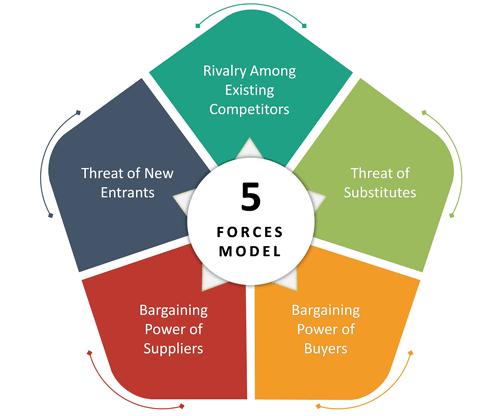
This refers to the numberof competitors and theirability to undercut a company. The largerthe numberof competitors, alongwith the numberof equivalentproducts and services they offer, the lesserthe powerof a company. Suppliers and buyers seek outacompany's competition if they are able to offera betterdeal orlowerprices. Conversely, when competitive rivalry is low, acompany has greater powerto charge higherprices and setthe terms of deals to achieve highersales and profits.
If there is intense rivalry in an industry, itwill encourage businesses to engage in
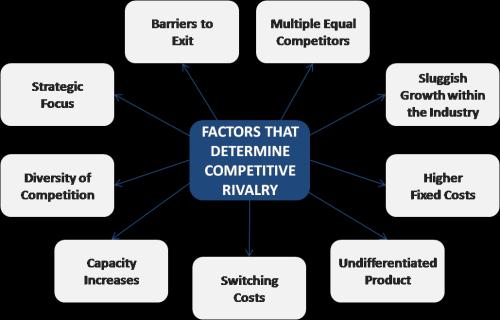
▪ Price wars (competitive price reductions)
▪ Investmentin innovation &new products
▪ Intensivepromotion (sales promotion and higher spendingon advertising)
▪ Size and Structure
▪ Technology - whatsystemthey use? Is itmore efficient then yourown company. Are you based online oris your company face to face. Brokers and conversions, how quickly can we contact our customers?
▪ Theirown individual company policy.
Value chain analysis is a process where a firm identifies its primary and support activities that add value to its final product and then analyse these activities to reduce costs or increase profits. It represents the internal activities a firm engages in when transforming inputs into outputs.
Value Added Chain Analysis was introduced by Michael Porter in 1985

Porter's four corners model is a predictive tool that helps in determining a competitor's course of action. Unlike other predictive models which predominantly rely on a firm's current strategy and capabilities to determine future strategy, Porter's model additionally calls for an understanding of what motivates the competitor.
This added dimension of understanding a competitor's internal culture, value system, mind-set, and assumptions helps in determining a much more accurate and realistic reading of a competitor's possible reactions in a given situation.

"Powerdynamics have many consequences, such as affectingdecision-making processes and influencingemployeebehaviour(Jex and Britt, 2008)."
• The concept treats 'power' as a managerial advantage that has many consequences - from affectingdecision-makingprocesses to influencing employee behaviour. Itexplores the characteristics of the powerin the workplace and outlines five powerbases.
• Poweris "the capacity to control one’s own and others’ resources and outcomes"(Galinsky et al., 2007). It is seen as the opposite of beingdependent; people who are powerful "depend less on the resources of those with low power than vice versaand, thus, are more easily able to satisfy theirown needs and desires. Powerhas often been considered a foundational force that governs social relationships. Because poweris so critical, it not only regulates social interactions but it also alters individual psychological states"(Galinsky etal., 2008).

• "Long hours are not a substitute for efficiency. Tasks not worth doingat all are not worth doingwell.
—Alexander R. Margulis"• Managingtime effectively is essential to maximise performance. The concept offers a review of different time management techniquesand highlightsthe main benefits, success factors, as well as some practical applicationsteps and case evidence.
• Time management is the process of organising, planningand controllingtime to get more and better work done in less time. It is defined as “behaviours that aim at achievingan effective use of time while performingcertain goal-directed activities (Claessens, 2007)” and “practices intended to maximise intellectualproductivity (Brittonand Tesser, 1991).”
• Time management can be viewed as a way of monitoringand controllingtime (Eilam and Aharon, 2003). Marquis and Huston (2009), on the other hand, argue that time cannot be managed at all; individuals can manage events in relation to time.
• "Modern organisation theory views the organisation as an open system, and reflects the fact that organisations operate in multiple environments and interact with numerous stakeholders (Daft, 1997)."
• Organisational theory puts substantial emphasis on people in organisations and how they are treated. An overview of the theory’s and strengths and drawbacks, measurement and focus areas helps leaders apply the principles in practice.
• "Companies need to understand fully theircore competencies and capabilities in order to successfully exploittheirresources (Javidan, 1998)"
• Core competence is among the best-known strategic managementconcepts. A core competence it is believed to constitute and sustain the firm’s competitive advantage. The importance of core competencies fororganisations is explored, in addition to technical capacities as one of the elements that allow organisations to be competitive in the market.
• "Core competencies are capabilities the firmemphasises and performs especially well while pursuingits vision."Core competencies can lead to competitive advantage when companies create value for customers exceedingthe value created by theircompetitors (Ireland et al., 2010:82).
• "KPIs should:(1) tell a story; (2) represent a reduction or construction of reality;(3) act as a base to spin a story around;(4) vary between organisations (Catasus et al., 2008)."
• Too often organisations combine other performance measures with that of KPIs, which can lead to difficulties in managingperformance and trackingsuccess. Practical implementation steps and case evidence provided helps leadersto focus on quality KPI’s that directly measure the areas needed in order to achieve success.
• Key performance indicators (KPIs) are agreed upon performance metrics designed to give managers and employees oversight of whether people are on track to meet targets and goals. In additionto end goals and results, KPIs provide a tool for definingwhat success looks like over an extended period of time. Multiple KPIs are often deployed simultaneously to provide a rounded picture of performance at individualand team levels (Ax et al., 2009; Kennerey & Neely, 2003).
• "Successful strategy execution has two basic rules: understand the managementcycle that links strategy and operations,and know what tools to apply at each stage of the cycle (Kaplan and Norton, 2008)."
• This concept offers a practical guide to using the Balanced Scorecard and is designed to assist executives to benefit from this strategic management technique.
• Balanced Scorecard Definition
• The Balanced Scorecard (BSC) is a strategic managementtechnique for communicatingand evaluatingthe achievementof the mission and strategy of the organisation usingboth financial and non-financial measures (Drury, 2004).
1. Understand the role of leadership in professional consulting
2. Understand strategies for optimising the way people are developed and led